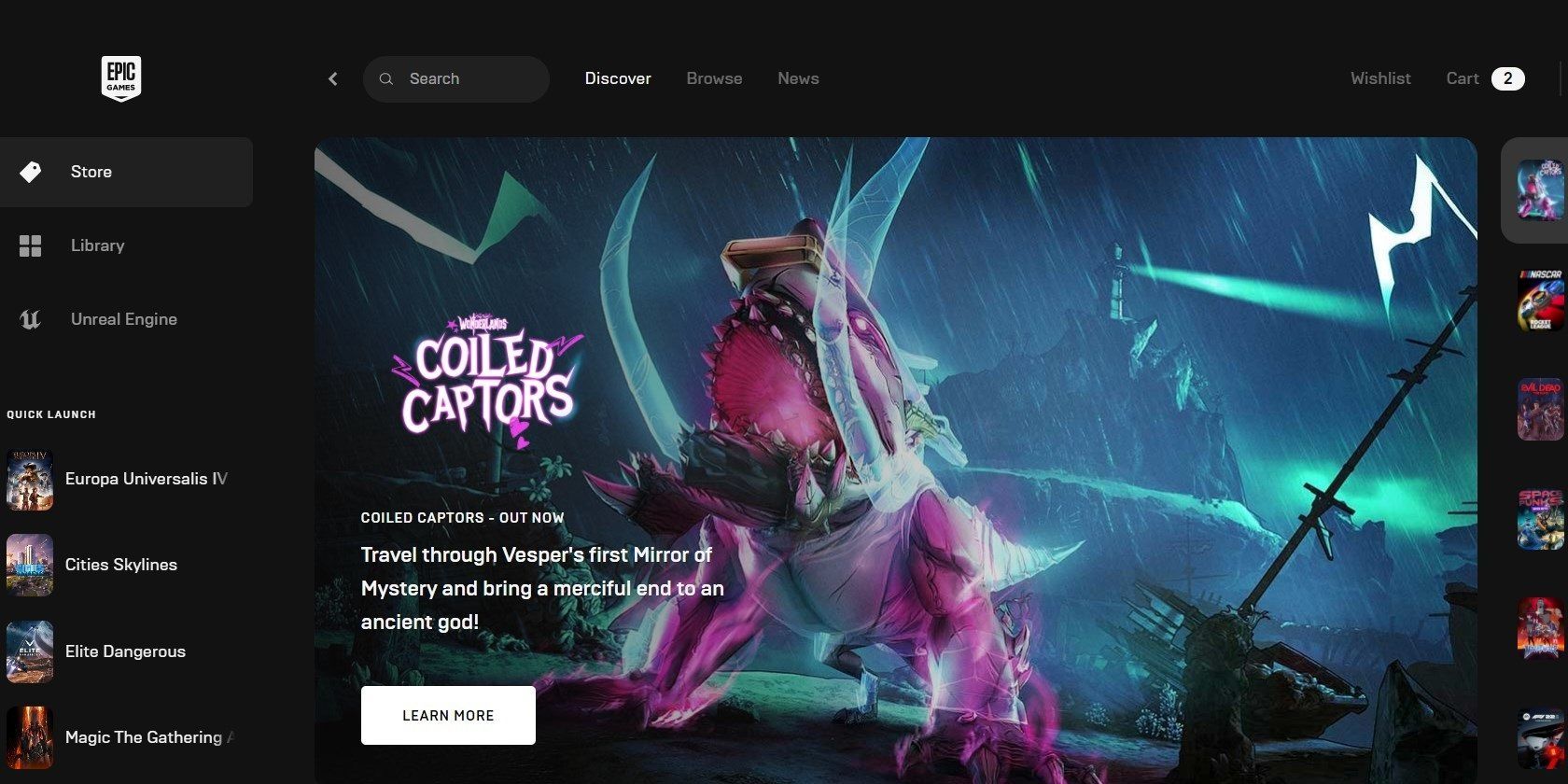Ronald.phillips
Shared posts
14 Most Memorable Kim Wexler Moments In Better Call Saul
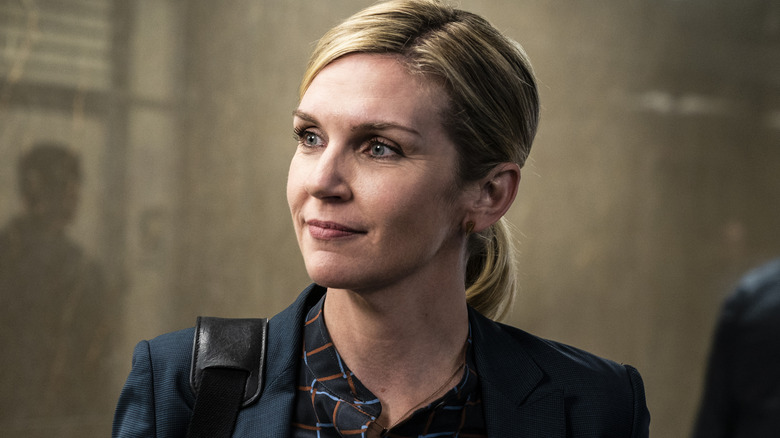
While "Breaking Bad" fans initially started watching "Better Call Saul" to see more of Bob Odenkirk's smooth-talking Jimmy McGill, they also tuned in to spend more time with his fierce co-partner in life and crime, Kim Wexler. Portrayed by actor Rhea Seehorn, public defender Kim Wexler isn't one to suffer fools. Kim starts off the series as the only chain-smoking friend that Jimmy can trust, and by Season 5, she's married to the ethically elusive lawyer. Watching Jimmy and Kim craft their unique way of seeing the law and life over the course of the series has been incredibly entertaining.
Throughout "Better Call Saul," people like Howard have blamed Jimmy for Kim's questionable actions. However, Kim always reinforces that she is her own woman, well aware of her moral compass. While she loves Jimmy, she never feels coerced by him, and won't hesitate to call him out. Although it's true that she crosses some legal lines she likely wouldn't have if it wasn't for Jimmy, she also encourages him to plan bigger cons. Jimmy and Kim might not always see eye-to-eye, but they demonstrate the same thirst and skill for a well-planned revenge scheme. From confronting a cartel boss to creating her own law practice, Kim Wexler is an unstoppable force. Below are some of her most courageous and jaw-dropping scenes in the hit AMC drama.
The First Time Kim Stands Up To Howard
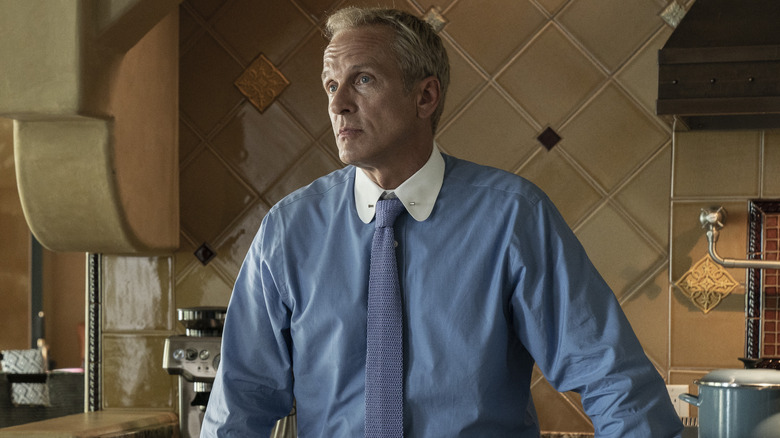
During Season 1 of "Better Call Saul," Kim Wexler was understandably wary of pursuing a relationship with Jimmy. While she worked side-by-side with him in the mailroom for years, she never made their close friendship public knowledge. Kim believed one day she would become a partner at Hamlin, Hamlin & McGill (HHM). Despite privately agreeing with Jimmy that he deserves more respect from the HHM partners — his brother Chuck and the arrogant Howard — she knew she couldn't risk upsetting her bosses by sticking up for Jimmy publicly. In her mind, she owed HHM for paying for her to go to law school and she needed to stay loyal to them.
However, her allegiance shifts when she sees Howard and Chuck not only dismiss Jimmy, but take credit for his work on the Sandpiper case. In Season 1, Episode 9 "Pimento," Kim stands up to Howard for commandeering the case Jimmy built from scratch. What stands out most about this moment is it's the first time Kim is willing to risk her reputation for supporting Jimmy. She can't walk away from an underdog, and she's willing to fight on Jimmy's behalf. Although Kim doesn't always agree with Jimmy's methods, she acknowledges that he works hard and is an excellent lawyer. Anyone that questions that fact will have to face her unstoppable wit and ironclad rhetoric skills. More importantly, this moment showcases Kim gaining the courage to step outside of Howard's patronizing shadow and be seen.
Kim's First Con
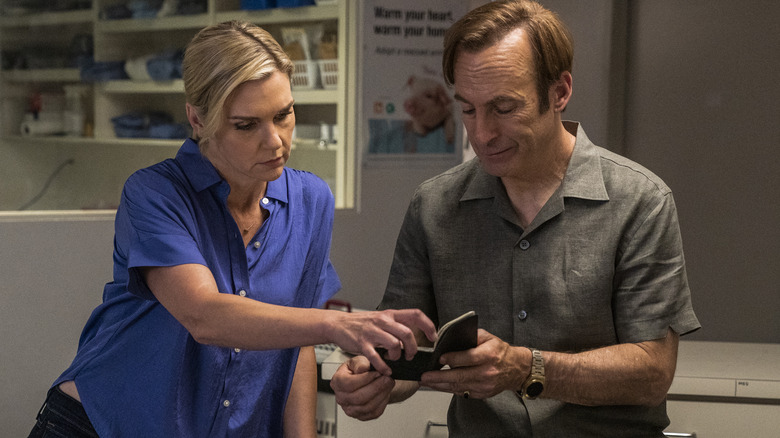
How can we possibly forget the first time Kim moonlighted as Giselle? In the Season 2 premiere of "Better Call Saul," Kim gets a taste of the Slippin' Jimmy life and partakes in her very first con. Written and directed by Thomas Schnauz, this episode answers a question that fans had been wondering about for some time: We know what Jimmy gets from Kim, but what can Kim possibly get from Jimmy? Throughout this episode, Kim gains a newfound respect for Jimmy's unique ability to read others and play exactly the right hand to get what he wants.
The pair pretend to be siblings with money to spend due to the death of a relative. They trick a stockbroker-bro, who was looking to profit on their investments, into buying them a bottle of Zafiro Añejo, a fictional tequila created by the "Breaking Bad" writers rumored to be inspired by a real-life $7,800 bottle of Hardy Cognac. After the rush of her first con, she sleeps with Jimmy and admits his life is far more interesting than hers. This moment marks not just the official start of Kim's romantic relationship with Jimmy but her realization that Jimmy's way of doing things has an upside. Sometimes the law won't be able to make the wealthy and corrupt citizens of Albuquerque, New Mexico pay (like the stockbroker trying to prey on the grieving) in the same way Jimmy can.
Kim Gives Jimmy The World's 2nd Best Lawyer Travel Mug
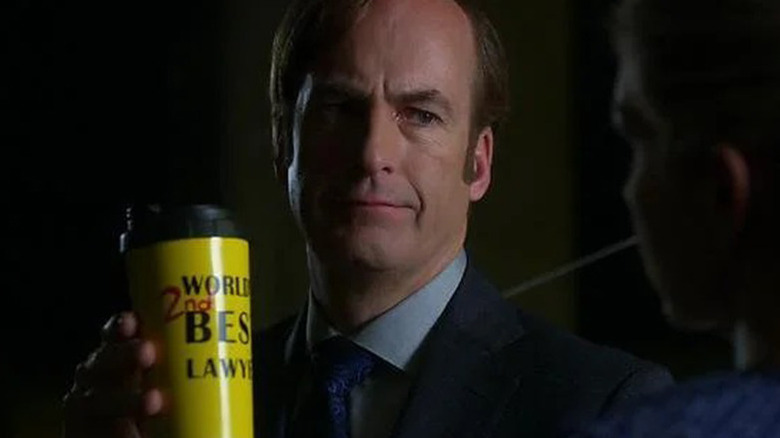
In Season 2, Episode 2 "Cobbler," Kim gives Jimmy a coffee travel mug calling him the world's second-best lawyer. While it's easy to dismiss Kim's gift as a tongue-in-cheek joke, it symbolizes something much deeper about their relationship. On the surface level, this gesture confirms that Kim will continue to date Jimmy. Kim gives Jimmy the gift for his new job at Davis & Main, symbolizing a fresh start for Jimmy and them as a couple. The pair then kiss and are on more stable grounds romantically than in prior episodes.
But this gift also showcases Kim's unwavering belief in herself. Kim is not the kind of partner who would worry about intimidating Jimmy or him taking the wrong meaning from a gift. Something changes between them after this point. When Jimmy needs legal advice after this moment, he doesn't solely rely on Chuck. He consults Kim because he values her perspective. Of course, she knows this. She wouldn't settle for less from Jimmy. Another television show could have written Kim as a character who enables Jimmy, sacrificing any spine she had. However, "Better Call Saul" never fails to remind the audience that Kim can handle herself. Being with Jimmy is a choice she makes, and this mug reminds Jimmy how lucky he is to have Kim in his life — even when it gets shot up with bullet holes.
Kim Takes Mesa Verde From HHM
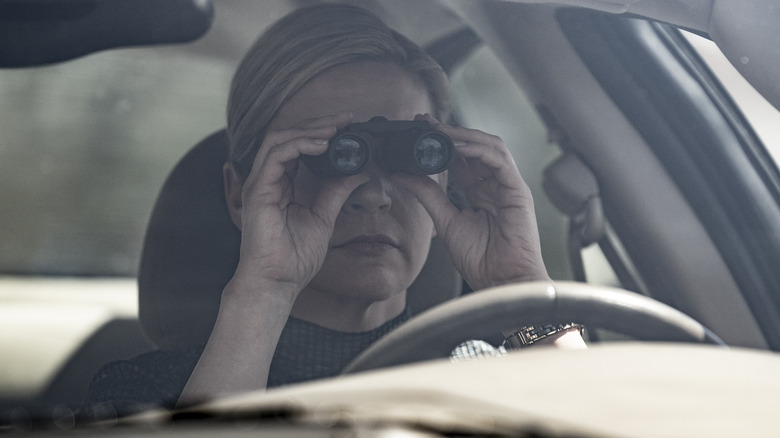
After Howard and Chuck learn Jimmy created a TV ad for his Sandpiper case without talking to Cliff first, they're livid. For purely patriarchal reasons, they interrogate Kim about whether or not she knew her boyfriend made and gave the go-ahead to run an ad for his case. Of course, Kim quickly puts them in their place by saying that she didn't think she needed to tell them anything. However, Howard does not see eye-to-eye with Kim and decides to punish her for Jimmy's trigger-happy actions. Howard sends Kim to the dust-filled basement for document review, which forces Kim to work until sunrise daily.
Angered at being punished for Jimmy's actions, Kim goes through all her contacts to find a white whale of a case for her to bring to HHM to redeem herself. Cue Kim landing Mesa Verde. In a way only Howard can pull off, he undercuts Kim again. He thanks her for the new client and then takes control of the Mesa Verde account. But in Season 2, Episode 9 "Nailed," Kim takes back the multi-million dollar deal. As an added bonus, Kim uses Mesa Verde's business to quit HHM and launch her practice in a career-defining move. Unfortunately for Howard, his entitled move(s) will have consequences that he can't quite see yet in Season 2. Burning Kim not once but twice will sow the seeds for her desire to destroy Howard's reputation throughout Season 6.
Kim Almost Works Herself To The Grave
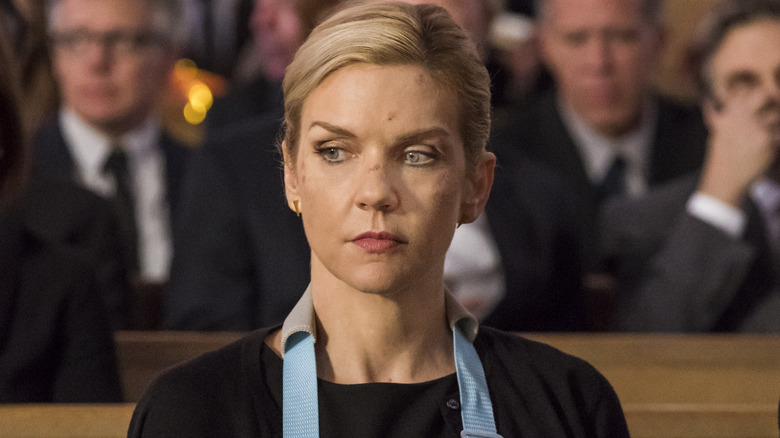
It's no secret that Kim is a boss. But Season 3, Episode 10 "Lantern" proves that even the most badass amongst us can burn out. What's most important about this moment for Kim Wexler isn't that she got into a car crash that almost killed her, though it's gut-wrenching to witness. Kim's car accident causes her to take inventory over her life. She worked so hard to prove herself to HHM so that they could pay for her to go to law school. After she became a lawyer, she worked even harder to make partner. After being burned by HHM, she built a solo practice. When Jimmy loses the ability to practice law, Kim convinces herself that she can work hard enough to pay their practices' lease. Kim has always pushed herself to achieve more.
In "Lantern," Kim gets the wake-up call to ask herself what she does or doesn't want. Is being on-call for Mesa Verde's every whim her style? Within this episode and the ones to follow, Kim examines her working life more critically. It was never her plan to go into banking law, so much as it paved a way out of HHM. After Kim takes the time to recover, she discovers what kind of law makes her the happiest to practice. Unlike Jimmy, she loves being a public defender. Without this accident, there's no telling how much longer Kim would have settled for less than she deserved in life.
Kim Chooses To Defend The Public Over Mesa Verde
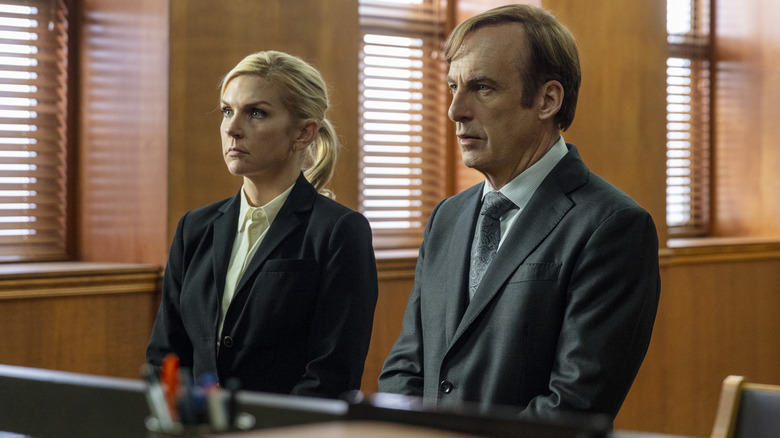
In Season 4, Episode 5 "Quite a Ride," Kim makes a vital step toward her eventual career track as a public defender. Although she tries to balance Mesa Verde's increasing demands with her pro-bono cases, this episode shows her deciding to put her individual clients ahead of the mega-bank. While she's helping out a client, Paige calls Kim, but Kim opts to ignore the call. Later in the episode, Paige, in no uncertain terms, tells her that Mesa Verde has to be her top priority. This moment inspires Kim to bring Mesa Verde's account to Schweikart & Cokely, spearheading a new banking division for them. Kim is then able to spread out her work amongst the division and spend additional time on her pro-bono cases.
What's important about this moment is that it shows a vital part of Kim's character: She fundamentally believes that she can have it all as long as she finds a way to make it work. Her decision to use a firm's resources to keep her account so that she can grow her client base sustainably proves how resourceful Kim is. Unlike Jimmy, who tries to weasel out of deals, Kim solidifies her reputation as someone who creates deals that benefit herself. Even Mesa Verde cannot intimidate her, which they'll learn later when they try to do so and utterly get burned by Kim and Jimmy.
Kim Saves Jimmy's Law License
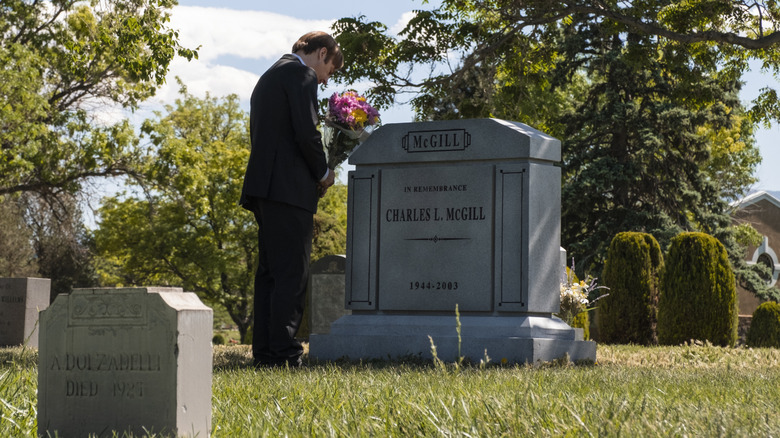
In a show like "Better Call Saul," most individuals are looking out solely for themselves. What makes Kim stand apart in this series is how she uses her wit and crafty intelligence to help others. When Jimmy is at risk of losing his law license for good, it's Kim who crafts the ultimate scheme to save the day. In Season 4, Episode 10 "Winner," Kim instructs Jimmy that he needs to be seen as a sympathetic figure if he wants to win his case. On the one-year anniversary of Chuck's death, Kim tells Jimmy to spend the whole day at Chuck's grave so that visiting lawyers and colleagues will see him grieving. Just as Kim predicted, fellow peers visit throughout the day and start gossiping about how bereft Jimmy is.
Furthermore, she tells Jimmy to spread a rumor that he anonymously donated money to build a library for Chuck at HHM. Although the library was paid for by HHM, people believe that the grieving brother privately set it up for Chuck. When it comes time for Jimmy to stand trial and defend his law license, the judges are quickly swayed and believe that Jimmy is turning over a new leaf. They no longer see him as a car salesman-like figure but as a man in pain. Without Kim, Jimmy would likely still be selling disposable cell phones on the street corner.
Kim Proposes To Jimmy ... Sort Of
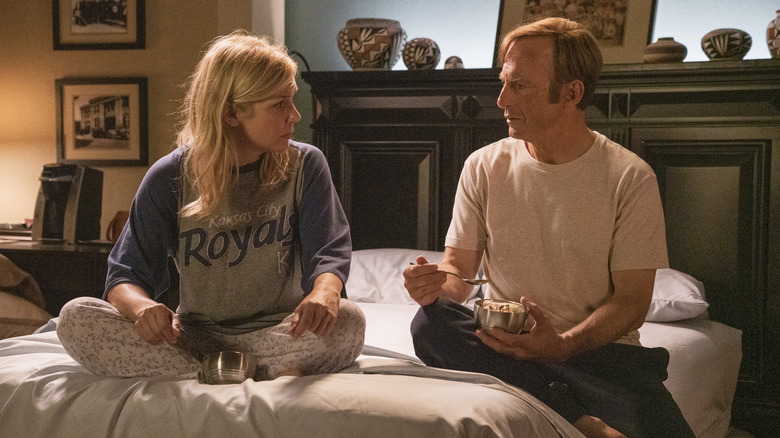
Kim and Jimmy's relationship goes through several rough patches. Mostly, they butt heads when Jimmy is involved in something he wants to tell Kim but can't. Not wanting to sacrifice her legal reputation, Kim previously told Jimmy that she doesn't want to know what con he's got going on so that she isn't culpable. However, it doesn't take long for Kim to feel shut out by Jimmy and scared about what he may or may not be up to during his business hours. As much as Kim doesn't suffer fools, she equally never wants to be treated as one.
While things with Mesa Verde were going okay, Kim becomes bored of the predictability of her work. What incites her further is when Mesa Verde decides to take over the land where Everett Acker lives — as he was leasing it from the bank — to build a new branch. Kim asks Jimmy for help running a con on Mesa Verde so that Acker won't lose his home. However, Jimmy shocks Kim by blackmailing Mesa Verde, which was not a part of their agreed-upon plan. Tired of being unaware of Jimmy's plans and their possible repercussions, Kim proposes they get married in Season 5, Episode 7. Thanks to spousal privilege, the pair's dynamic changes for the better. Even if Kim doesn't approve of what Jimmy does, she knows she'll never hear him omitting the truth again for her sake.
Kim Tells Off Lalo Salamanca
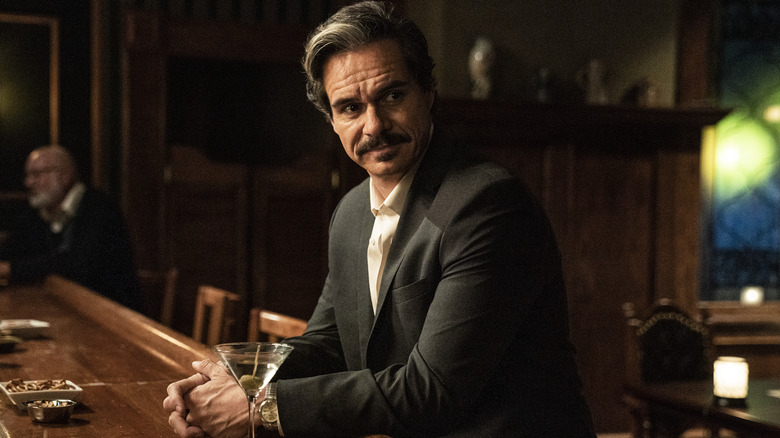
While Kim has several standout monologues in "Better Call Saul," there are none that are as memorable as when she tells off Lalo Salamanca. In Season 5, Episode 9 "Bad Choice Road," Jimmy is still out in the desert with Mike after their money drop-off went sideways. Kim, overcome with worry, decides to confront Lalo in his holding cell. Without blinking, Kim (rightfully) blames Lalo for Jimmy's disappearance and criticizes his business operation. Few people in the "Better Call Saul" universe have successfully stood up to Lalo, never mind having the gall to tell him to "get his house in order." She cleverly deduces that the only reason he'd use his lawyer as a bagman is that he doesn't trust anyone who works for him, which reflects poorly on his management style. Kim's brazenness amuses Lalo, who tells her that Jimmy is a lucky man to have someone like her in his corner.
In a certain light, you could almost see Kim becoming a better version of Walter White in "Better Call Saul." That's not quite where the series takes Kim, but this moment marks the start of her not being afraid to go toe-to-toe with nefarious forces. While some fans argue that Jimmy influenced this side of Kim to emerge, this moment demonstrates that her steely confidence and silver tongue are skills that come naturally to her. She just uses them discerningly for when it helps her self-interest and those she loves.
Kim Sets Howard's Demise Into Motion
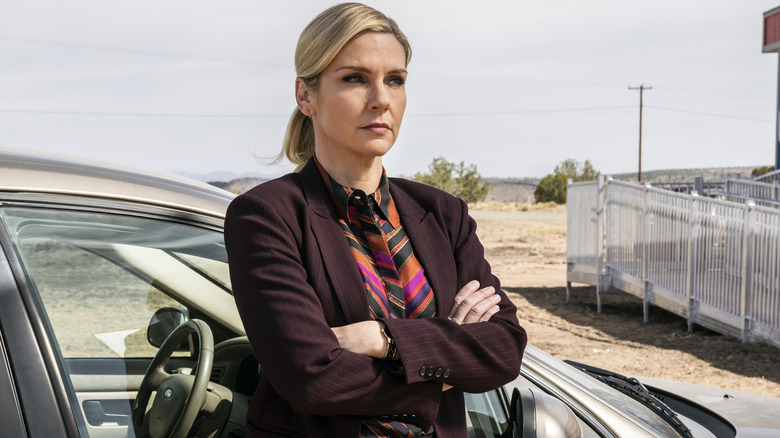
Kim is not one to forgive or forget easily. No one learns this truth better than Howard Hamlin. In Season 5's finale, "Something Unforgivable," Kim decides it's time to get revenge on Howard for all the times he undermined her and assumed that she only ever does what Jimmy wants. Although this shocked Jimmy, he's more than happy to plot Howard's downfall, especially after the ways Howard dismissed him and seeded the divide between him and Chuck. A lot of fans see this moment as a turning point for Kim's character, as she's now someone who delights in ruining someone and laughs at how she could humiliate Howard. However, this isn't just about personal vendettas. Kim wants Jimmy (and de-facto herself) to have access to the $7 million Sandpiper settlement that's tied up with HHM.
When speaking to THR, "Better Call Saul" executive producer Melissa Bernstein confirmed that Kim's path would only get darker in Season 6: "We've seen [Kim] navigate some unsavory personalities and glean information when it's advantageous to her and Jimmy." Referring to Kim's treatment of Viola in Season 6, Bernstein added, "But to do that to a character that we all like as an audience, somebody who is professing how much she admires Kim, is very, very low. To do what she's doing and to do it in such a friendly, disarming way is pretty shameful." Move over, Gus Fring.
Kim Unveils The Kettlemans' Latest Scam
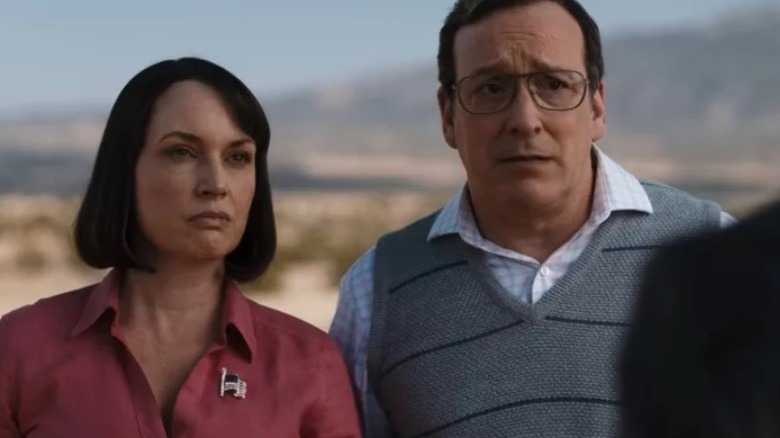
In "Better Call Saul" Season 6, Episode 2 "Carrot and Stick," Kim proves to Jimmy that sometimes you don't need to grease the wheels to get what you want. For a certain kind of person, they'll only respond to dire consequences. Despite Jimmy thinking he could convince the Kettlemans to forget what he told them about Howard's addiction, they are hell-bent on finding a way to punish Jimmy for almost tricking them. Although it's clear that the Kettlemans don't know the long (or short) game that Jimmy is playing, they are the type to cause an unneeded scene, which could ruin Kim and Jimmy's con.
Cue Kim's ruthless entrance. It takes Kim less than five minutes of walking through their gaudy accounting office to deduce the Kettlemans' latest scam. Kim figures out that they have been skimming off the top of their clients' tax refunds, taking a larger sum for themselves. Although the Kettlemans deny this, Kim calmly sits down and calls a good ol' friend at the IRS with a specialty in tax fraud. Scared of being tried for fraud again, the Kettlemans let Jimmy and Kim go and vow to forget anything Jimmy said about Howard. Once again, we see how when Jimmy and Kim are pushed into a corner, Kim manages to find a legal loophole to save the day. This moment also shows Kim's growing knack for understanding what makes a clever scam work.
Kim Confronts ADA Suzanne Ericsen
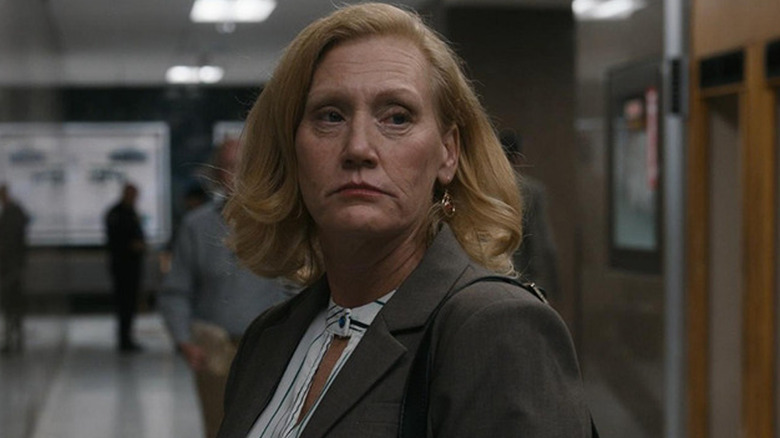
Once Kim married Jimmy, plenty of characters in "Better Call Saul" voiced their opinions about their union. However, none were as insulting and shameless as ADA Suzanne Ericsen. Following Jimmy's decision to represent Lalo Salamanca, Ericsen starts keeping tabs on Jimmy's involvement with the Mexican cartel. Further, she spreads rumors around the courthouse that Jimmy is a dirty lawyer, which hurts his professional reputation.
In Season 6, Episode 3 "Rock and Hard Place," Ericsen asks to speak privately with Kim about Jimmy. The ADA tells Kim that she's worried that Jimmy is somehow wrapped up in something sinister. She tries to appease Kim by saying that she's sure Jimmy didn't know who Lalo was, and asks for Kim to convince Jimmy to feed the defense department information on the cartel. Insulted that Ericsen would so blatantly feign sincerity to gain access to information to help her career, Kim confronts her. She reminds Ericsen that she's the same person who called her husband a "scumbag," so she's not doing her any favors.
What's great about this moment isn't just Kim sticking up for Jimmy, but she sees through Ericsen's "altruistic" motivations. Of course, Kim knows what is truly upsetting her. Ericsen's not upset that Jimmy represented Lalo; she's angry that her team and the state had Lalo in custody and unwittingly released him on bail.
Kim (Once Again) Creates A Job For Herself
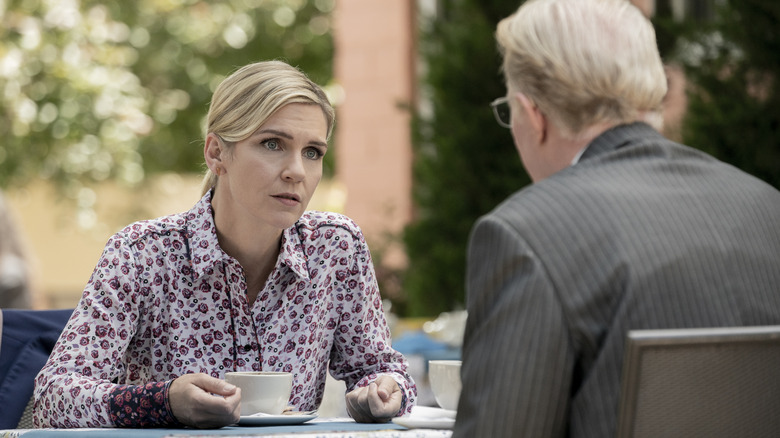
In Season 6, Episode 4 "Hit and Run," Kim ends up creating her dream job while simultaneously running a Howard-destroying con with Jimmy. As a way to distract Cliff, Kim asks Cliff to meet up for coffee. As part of a way to keep Cliff focused on the exact moment that Jimmy (in disguise as Howard) arrives, she says she wants to talk about work. Kim pitches Cliff the idea to start a pro-bono law practice, and she asks for his connections to help her get started. While Kim's pitch wasn't rooted in any true job plan per se, Cliff believes so much in Kim's work that he tells her he's interested in the idea. Not only does Kim succeed in keeping Cliff occupied but she once again creates a job for herself out of thin air.
While Season 6 shows Kim descending into unethical behaviors, it's nevertheless displaying the rewards of Kim's risk-taking pursuits. Although she's aiming to destroy Howard professionally, she's never lost sight of her simultaneous desire to help the underdog. Even if opening a pro-bono practice won't make up for her lies, Kim is still using these darker aspects of herself to achieve what the rulebook version of herself never could. When Rhea Seehorn was asked if she believed Kim and/or Jimmy corrupted each other, she told Looper, "They both are very flawed. They are going down similar rabbit holes and we'll see who can pull the brakes."
No One Can Tail Kim Wexler
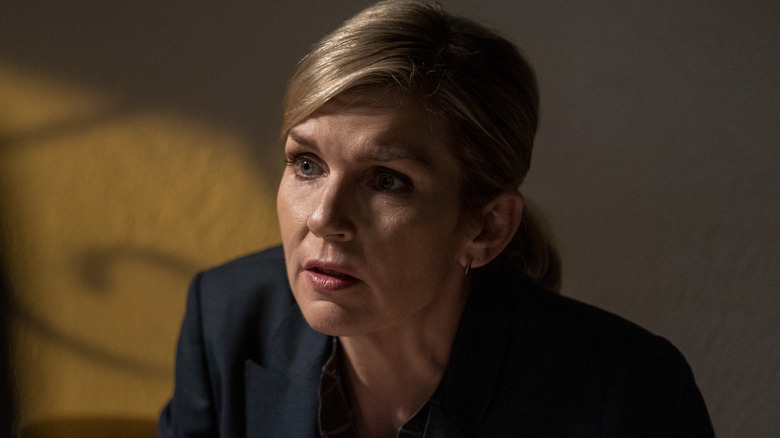
Following Kim standing up to Ericsen, she notices a sedan has been tailing her car for a couple of days. When she tells Jimmy, he handwaves that away. He tells her she's seeing things because she feels guilty about pulling off their latest part of the long-Howard-con. However, Kim follows her gut and makes notes of the car's plates. Although most "Better Call Saul" characters might stop there, Kim Wexler doesn't. She confronts the car that is tailing her, regardless if the men inside are private investigators working for the ADA or Lalo's crew. She tells the mysterious men to back off or she'll call the cops and say she's being harassed.
In Season 6, Episode 4 "Hit and Run," Kim doesn't think twice before confronting men that could have easily killed her. Mike soon arrives on the scene and tells Kim the truth. His men followed her just in case Lalo showed up. Mike apologizes for the stress and promises he has no intention of hurting Jimmy or her. He also seems low-key impressed that Kim was able to spot the tail. When Kim asks Mike why he confided in her about Lalo possibly being alive, he tells her she's made of "stronger stuff" than Jimmy. As "Breaking Bad" and "Better Call Saul" has shown best, Mike doesn't trust people easily. But with one meeting, Kim has already won him over — which is more than Jimmy can say.
Read this next: The 18 Best Crime Dramas In TV History
The post 14 Most Memorable Kim Wexler Moments In Better Call Saul appeared first on /Film.
Hades Nails Its Depictions of Polyamory and Kink
Elden Ring Steam and Lan fix with Seamless coop mod
Fallout 4 - Point Lookout DLC available
Iliza Shlesinger: Freezing Hot (2015) [WEBRip] [1080p] [YTS.MX]
TV, Interrupted: Girlboss Is Netflix's Greatest Guilty Pleasure

(Welcome to TV, Interrupted, a series where the /Film team remembers, eulogizes, and makes a case for the revival of TV shows we loved that were canceled far too soon.)
While musing over the name for her new business selling cheap thrift store clothing for a mark-up on eBay, "Girlboss" protagonist Sophia (Britt Robertson) muses carefully over the perfect combination of words that will summarize her personality, her brand, her image, and comes up with "White ... b****."
That's not the name she ends up going with, but it's not far off. Created by Kay Cannon ("Pitch Perfect"), the show is loosely ("real loose," as the opening of each episode warns) based on the true story of Nasty Gal founder Sophia Amoruso and her memoir "#Girlboss." Diagnosed with depression and ADHD in her teens, Amoruso dropped out of school and bounced from minimum wage job to minimum wage job before starting her eBay business at the tender age of 22. Several studies have shown a link between ADHD and entrepreneurship, perhaps as a reflexive escape from the unbearable monotony of the 9-to-5 job, and the Sophia in "Girlboss" certainly captures that spirit of stumbling upon success as a side effect of thrashing back against the stifling boredom of adult life.
"Girlboss" season 1 covers Sophia's journey from reselling a single awesome jacket for a massive profit to finally launching the Nasty Gal website, independent from its former eBay trappings. And one season was all we ever got, because Netflix quickly canceled the series. "Girlboss" joined the heaving mass of short-lived Netflix shows that have since been drowned under the weekly waves of new Content. But grab a snorkel and dive in, because "Girlboss" is gold standard guilty pleasure viewing.
Why Girlboss Was Great
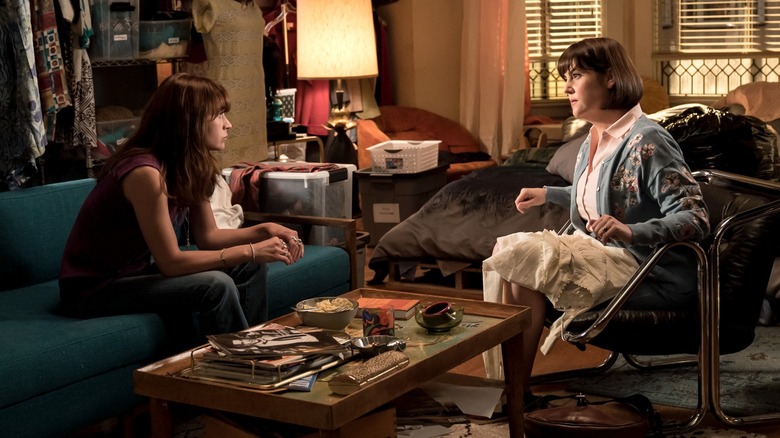
Has the initial hate subsided enough for me to make the case that "Girlboss" is sorely underrated? I suppose we'll find out. But certainly this is one Netflix show that I've found myself returning to over and over again.
"Girlboss" is perfect comfort TV. It's funny in that "Gilmore Girls," mile-a-minute quips, larger-than-life characters sort of way. It's major nostalgia-bait for those who entered the adult world in the mid-2000s. The cinematography is bright and colorful. It has dress-up montages and a bland-but-hot love interest. It has a great best-friend dynamic between Robertson and Ellie Reed, who plays Sophia's longtime BFF Annie -- and yes, we get an episode where you find out how they first met, á la the "Broad City" episode "Sliding Doors."
The stellar cast doesn't end there. Also among the supporting players are Jim Rash ("Community"), Dean Norris ("Breaking Bad") and RuPaul (of "RuPaul's Drag Race") fame. But the real highlight is an endlessly entertaining guest performance from "Yellowjackets" star Melanie Lynskey, who plays a neurotic, introverted vintage clothes connoisseur who ruthlessly goes to war against Sophia's careless attitude of cutting up and restyling clothes instead of carefully preserving them in a box with acid-free tissue paper.
Why Girlboss Was Canceled

Well, it got mostly bad reviews and was the internet's favorite punching bag for about a week. Really, it would have been a far greater surprise if "Girlboss" hadn't been confined to a single season. But let's dive a little deeper into why the show was so poorly reviewed, and why it made such a good punching bag.
"Girlboss" came out in 2017, when the word "girlboss" itself was already starting to fall out of favor and towards the plateau of purely ironic use. But the word "problematic" was still very much in vogue, and "Girlboss" had plenty of hooks upon which to hang the "problematic" label (not the least of which is RuPaul's character, who embodies a sassy-gay-Black-friend-who-only-exists-to-be-a-sounding-board-for-the-protagonist trope that should have been retired about a decade ago).
Then there's the girlboss herself. Sophia is selfish, bad-tempered, irresponsible, loud, abrasive, and childish -- labels that she wears proudly, for the most part. Now, at the time it wasn't necessarily verboten for female protagonists to be flawed to the point of monstrous or to make consistently terrible decisions; just look at the success of "Crazy Ex-Girlfriend," which debuted a couple of years earlier. But whereas Rebecca's exploits in "Crazy Ex-Girlfriend" typically resulted in pratfalls and humiliations, Sophia's were coupled with a rags-to-riches success story, and the use of "girlboss" in the title was mostly sincere, not ironic.
Then of course there's the problem of the real-life rags-to-riches success story that the show was based on -- which, by 2017, was a rags-to-riches-to-bankruptcy story. Sophia Amoruso stepped down as CEO of Nasty Gal in 2015, and the company filed for chapter 11 bankruptcy the following year. Employee reviews described the company as suffering from "pervasive low morale" and described Amoruso herself as "wildly disconnected from the reality of business."
Amoruso herself seems to agree with that assessment; speaking to Forbes after her departure from Nasty Gal, the advice she offered to wannabe entrepreneurs was to "get some real management chops [and] know more than I did before you try to do what I've done." The show itself is thoroughly unflattering and makes little effort to sand off Amoruso's rough edges (one episode centers around Sophia being outraged that Annie would dare to request a full-time paid job at Nasty Gal after putting in countless hours of unpaid labor). But Sophia is still the protagonist, and we're still ultimately supposed to root for her and for the successful launch of Nasty Gal. And that was, well ... problematic.
Unfinished Business
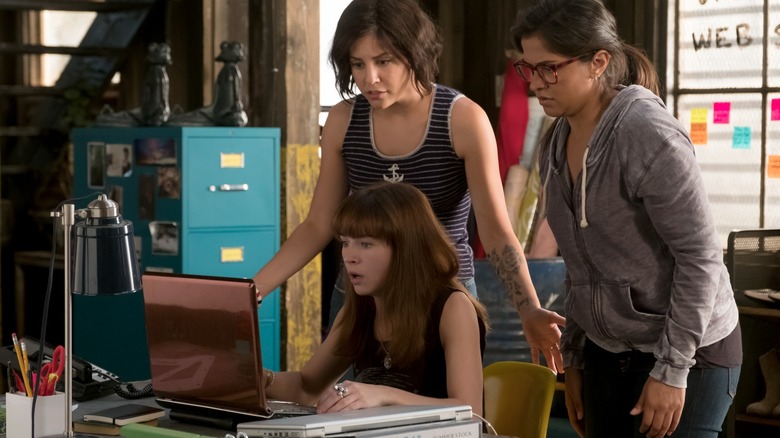
Perhaps the saddest thing about the cancelation of "Girlboss" is the fact that we never got to see Sophia truly fail, and she only really grows as a person in small increments. In the show's first and only season, she's a selfish, self-centered, self-declared "b****" who's constantly screwing things up. You frequently find yourself cringing as she stumbles into yet another easily-avoided mishap. But then again, if any one of us was to watch a TV show based on ourselves in our early 20s, we'd probably end up cringing three times as much. Let she who did not spend her early 20s making bad decisions and wallowing in navel-gazing cast the first stone.
If "Girlboss" has a counterpart here in the U.K., it would have to be the comedy series "Fresh Meat." That show follows a group of housemates through three years at university, from the start of their degrees to the end (approximately from the ages of 18 to 22). And like Sophia, they are for the most part a truly terrible and embarrassing collection of human beings, making disastrous choices while voicing ignorant and high-minded opinions with a confidence that not one of them has earned.
But that's kind of what happens in your late teens and early 20s. There's a popular narrative that life is a steady decline from the promise and potential of youth to the disappointment and unfulfilled dreams of later adult life ... but ideally, you should be the worst possible version of your adult self at 18. Just as children go from the "terrible twos" of toddlerhood to (hopefully) learning empathy and self-control as they get older, so too can they continue to learn and improve after flying the nest and embarking on an independent life as young adults. And the road to self-improvement is paved with catastrophic mistakes.
The season 1 finale of "Girlboss" feels like a distinctly unearned and unsatisfying happy ending for Sophia. It's like if "The Wolf of Wall Street" ended at the high point of Jordan Belfort's career, before the FBI caught up to him, or if "Catch Me If You Can" had ended before Frank Abagnale was actually caught. That's because "Girlboss" isn't really a rags-to-riches success story; it's an Icarus story about a meteoric rise followed by a downfall. We just never got to see the downfall.
Will Girlboss Ever Return?
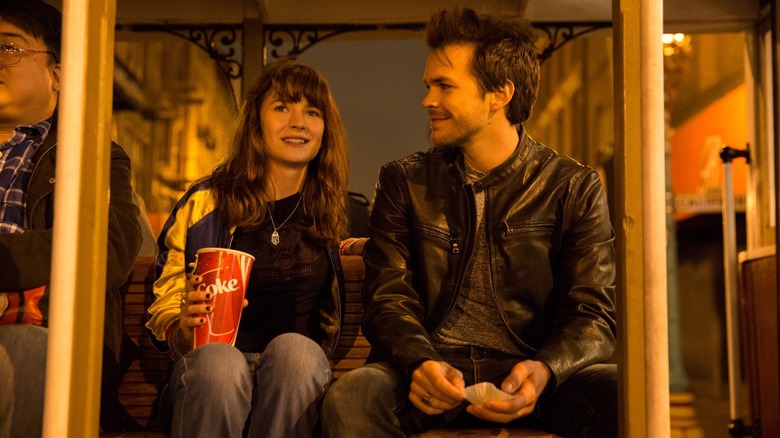
Oh no, no way. And honestly, that might be for the best. The discourse was tiring enough the first time around; who wants to sit through another round of finger-wagging hot takes about how "Girlboss" is a Bad Feminist Show That's Bad at Feminism? But for what it's worth, here's what season 2 would have been about, according to showrunner Kay Cannon:
"We would see more of her rise. It's unclear if she'd move to L.A. or not, but we'd see some of the bumps of actually being a boss to people. What we'll do in the show is this idea of understanding what your strengths and weaknesses are. A big weakness of Sophia's is that she has no business managing people, especially when they're her friends, and how these friends could possibly take advantage of having their very young boss be their friend at the same time. We'll explore all of that."
So keep that in mind and take the season 1 finale as it was intended: a high point that preceded a whole bunch of other peaks and valleys that we'll never get to see. "Girlboss" was here for a good time, not for a long time.
Read this next: The 15 Best Netflix Original Series Of 2021 Ranked
The post TV, Interrupted: Girlboss Is Netflix's Greatest Guilty Pleasure appeared first on /Film.
New Linux-Based Ransomware Targets VMware Servers
Read more of this story at Slashdot.
Hey Microsoft, it’s time to make a better web browser
A few days ago, I launched Microsoft’s Edge browser to check some things that I specifically use it for. I was greeted by the dialog that we’ve probably all seen by now, the one that suggests you switch to Microsoft’s suggested settings. Of course, the box to switch is pre-selected for you. It’s easy enough to dismiss, as I’ve done dozens of times at this point.
But this time, I didn’t think, and I just clicked apply. I immediately realized my mistake, went into Edge settings, and changed by default search engine back to Google. Not thinking about it, I later clicked on a link in Slack, and sure enough, my default browser had been changed to Edge. There was never any dialog box to specifically change it, as there would be if any other browser wanted to become the default. And then, I had to go through Windows 11’s nightmarish settings to turn my default browser back to Vivaldi.
I don’t even like Vivaldi. It’s a buggy mess, despite being a very clean experience. But I’ll take it any day over Edge. And after having to switch my browser back, I realized, Microsoft should really be doing a better job of this.
That’s not all that’s wrong with Microsoft Edge. The browser is a faint echo of what it was once promised to be. Now it’s designed as a way to trick you into adopting Microsoft services and a way to spam you with content you don’t want to see.
A brief history of Microsoft Edge
When Microsoft revamped Edge from Google’s open-source Chromium, it wasn’t the first time that the Redmond firm promised that the browser would be good. When Windows 10 was first being announced, it was to come with a brand-new browser, which was only known as Project Spartan at the time. Spartan was going to have innovative new features like the ability to use a pen to write on webpages and save them.
It’s pretty clear where that all headed. Spartan became Edge, a browser that was built on Microsoft’s own EdgeHTML engine. The company did its best to keep up with web standards, but there was always an issue that Edge couldn’t be updated unless Windows was getting a feature update. While Chrome was getting updated every six weeks, Edge got updated every six months. On top of that, Chrome is so dominant when it comes to usage share that the internet is just built for it.
Edge never picked up steam, despite Microsoft continuously trying to improve it. One day, someone from the Edge team asked me what would need to happen for me to use their browser. I jokingly replied that they’d have to turn it into Chrome, the browser I was using at the time.
As it turned out, the team had something similar in mind. Microsoft Edge was to be rebuilt from Chromium, and fans of the company’s products rejoiced. It was an exciting time. Finally, Microsoft fans would have a decent browser to use without having to go to Google. Moreover, Edge was also coming to macOS, iOS, Android, and even Linux, so you’d be able to sync your browsing history to all of your devices.
When it first launched in Canary and Dev channels, it was good, really good. The browser seamlessly imported your history, passwords, and more from Chrome, and then it was just a clean experience. Sure, Microsoft set the default browser to Bing, but you could change it, and that was to be expected, right?
After announcing Edge Chromium in December 2018, it was generally available on January 15, 2020. It was missing key features, such as history sync, something that’s basic for Chrome users. Eventually, all of these features arrived.
Despite delays to core features, it did seem like Microsoft was on the right track toward a great browser. The only problem was that it really wasn’t usable. If you can’t sync your history between devices, any sane person would stick with Chrome until you can.
Edge now exists as a means to push Bing and other Microsoft services
Bing is a bad search engine. I consistently find better results on Google, and I’m pretty sure that exactly no one is tailoring their SEO for Bing. It simply doesn’t have enough users. It’s kind of the same problem that the old Edge has. The web is built around Google now.
The problem is that Bing powers a lot of Microsoft’s efforts, not just web searches from Bing.com. That means that despite the fact that so few people use it that you’d expect for it to be killed off, Microsoft actually does care quite a bit about it.
I, however, would prefer it if I could never see Bing again. Every single time I see a Bing search page, it’s by accident. It means I forgot to change the default search in some browser I’m using. And Microsoft actively tries to push me to use it.
For example, I opened with that story about how Edge occasionally just tosses up a pop-up to tell you to use recommended settings. That pop-up is misleading too, and it makes Edge feel more like malware than anything else. It’s just saying that your settings have somehow been changed from what’s recommended and that it’s a problem you should fix.
And of course, if you change your default search engine, that’s one of the settings that won’t sync. This is behavior that I’d expect, and I’m not particularly mad about it on its own. But this is cumulative. It’s on top of a whole bunch of other stuff that feels like cheap tricks to get you to use Bing.
Microsoft has always been bad with cheap tricks
The problem here is that Microsoft doesn’t realize how bad of a user experience it’s providing. The people that want to use Bing most likely are already, and the ones that don’t are just going to get annoyed when Edge tricks them into using it.
Let’s turn the clock back a bit. Windows RT was a version of Windows 8 that ran on Arm processors, but you could only run apps from the Store. Unfortunately, Microsoft didn’t communicate this very well, and Windows RT looked exactly like regular Windows, so you’d go and buy a Surface RT, and then try to install Chrome – which said it would run on Windows 7 or higher – and it didn’t work. That’s a ‘gotcha moment’.
Fast forward a bit to the next time that Microsoft wanted to force everyone to use Store apps, with Windows 10 S. The big difference was that you’d be able to pay to upgrade from Windows 10 S to Windows 10 Pro, giving you an out. Of course, that makes for a terrible experience for consumers, when they buy a premium PC like the Surface Laptop for a thousand dollars, only to find out when they get home that they have to pay another $100 to install the apps that they want. That’s a gotcha moment.
Tricking you into switching your default browser is another gotcha moment. There’s no one that goes through that and comes out on the other end grateful that they ended up using Bing.
The new tab page is a disgusting mess
One of the reasons I choose Vivaldi despite how buggy it is is that the new page can have almost nothing on it. That’s what I want. The new tab page in Edge is so bad that it almost gives me a headache. And yes, you can customize it, but I don’t have the time to do that on every new PC, nor should I have to.
At the top is a search bar, powered by Bing, as you’d guess. Below are shortcuts to frequently viewed websites, which is fine.
We have @vivaldibrowser and @MicrosoftEdge
Which new tab page is better? More peaceful? Pleasant? Less disruptive to your FLOW? pic.twitter.com/AZn3Zs9Mpj
— Richard Woods (@TheRichWoods) October 6, 2021
Below that is what basically feels like spam. Labeled as “My Feed”, it’s a bunch of stuff that I wouldn’t care about in a million years, such as headlines about Rihanna’s child, what Britney Spears posted on Instagram, football news, and more. There are also ads with headlines like, “Is a Recession Coming? 5 Things To Do ASAP”, and frankly, it blends right in with the quality of content I’m seeing natively.
The thing is, even if the content was relevant, I wouldn’t want to see any of that. Why would anyone want a busy, noisy new tab page? I don’t know about you, but when I click that ‘+’ icon to open a new tab, I have a pretty good idea of what I want to do with it. I don’t need suggestions.
While I look at the ads and the headlines, it feels like just another way for Microsoft to monetize its browser instead of actually making it a good experience. The problem is that if you sacrifice a good experience in the name of monetization, no one will use it. So you lose out on the experience and the monetization along with it.
Syncing is slow
I’m something of a rare use case because I’m activating a new Windows PC just about every week. That means that I’m setting up a browser. The old joke for Internet Explorer, and later Edge, was that it’s a Chrome installer. And aside from the year or so that I used it as a default browser before I couldn’t take it anymore, one of the first things I do on a new PC is use Edge to download a new browser.
Let me put it this way. When I set up a new PC, I can open Edge, download Vivaldi, sign in to Vivaldi, and have all of my passwords and favorites sync in Vivaldi long before any of them appear in Microsoft Edge. Edge simply isn’t very good at syncing. Oh, and that amount of time doesn’t include the 10-second animation you have to go through just to open Edge for the first time.
Also, sometimes there are bugs in syncing. I had an issue once with Edge where every time I signed in, it switched the browser to light mode, and I’d have to change it to the system setting. This was eventually resolved, but at the time, no matter how many times I’d change the setting, it would still be changed back on a new PC. This went on for months and months.
That’s just one example of several, and if it was just that one bug that got fixed, I wouldn’t even mention it. But it’s not, and syncing is that important in a modern browser in this multi-device world.
Edge was supposed to be good, and some things are good
Microsoft Edge was supposed to bring balance to the force, so to speak. If you’re a Microsoft fan, you’re probably not much of a Google fan, so basically getting Chrome but with Microsoft services seemed perfect.
The team started out on such a good track too. Everything was seamless. When opening Edge Chromium, you’d get a simple message asking if you wanted to import your things from Chrome, and once you did, you could quite literally pick up in Edge where you left off in Chrome. It was great. But Microsoft did what Microsoft does; it continued to add new features instead of improving the features that actually matter.
Some things are still good though.
Microsoft Edge is the only Chromium browser that works natively on Arm
If you use Windows on Arm, then you know that your choice in decent browsers is limited. While Windows 11 can emulate any x64 app on an ARM64 processor, you’ll probably want a browser that runs natively. For that, your only choices are Edge and Firefox.
As a matter of fact, Google does indeed have Chrome ready to go, and has for years. It just hasn’t released it.
Edge still has excellent inking features
One cool thing about Microsoft Edge is inking, specifically for PDFs. When a company sends me an NDA or a loan agreement, I just open it in Edge, sign it with that PC’s pen, save it, and send it back. It’s fantastic.
Of course, you can do more, such as highlighting and stuff. It’s just nice to have a simple, easy, and free way to write on PDFs.
Microsoft needs to do better
I want Microsoft Edge to be good. I really do. Like I said earlier, I set up a new Windows PC almost every week. I don’t want to install extra software if I don’t have to.
I currently use Vivaldi. There was a bug for months where I’d try to type something in the URL bar, and it would just repopulate with the existing URL. It was infuriating. Autofill URLs never seem to be quite right. Tab management seems to have a bug in it right now where you have to pull tabs away from the window just to split them away from the main window.
But it’s still better than Edge. Microsoft likes to talk about your “flow”. You know, that’s when you’re doing something on your PC and you’re just in your groove. That can be when doing anything. You’re passionate about something, you’re creating it, and you’re just in the zone. The idea is that the Redmond firm wants to create products that help keep you in your flow, not distract from it.
Microsoft Edge distracts from your flow. It’s a bad browser, which is a shame, because it should, and totally could be good. All Microsoft would have to do is work on improving existing features instead of adding useless new ones, and stop with the cheap tricks to get people to use their services like Bing. Unfortunately, those things are unlikely. It’s very much Microsoft’s culture to launch new features instead of improving the core features, and the monetization angle is always going to be a key component of how Microsoft operates. Other companies might say that providing a great experience would lead to monetization, but that’s not how this is going to go.
The post Hey Microsoft, it’s time to make a better web browser appeared first on XDA.
OmegA (Full Game) (2.4) (Windows/Linux/Mac M1)

Now compatible with Quake III maps and removing of the upscalled textures. For Mac M1, look at the description for installing.
Why Christopher Lee Almost Never Spoke In His Dracula Movies
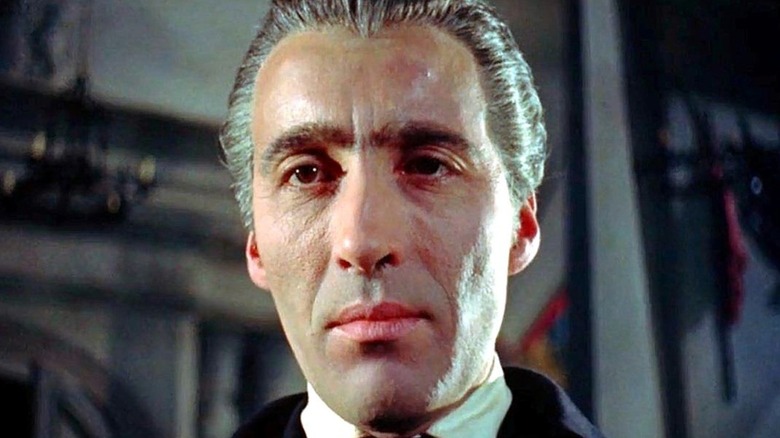
On May 27, 2022, we celebrated what would have been Sir Christopher Lee's 100th birthday. Although the legendary actor is no longer with us, he lived a life that "remarkable" doesn't even begin to cover. After a tour as an intelligence officer in the British Royal Air Force during World War II, Lee appeared in over 250 films. He's particularly renowned for his work in the horror genre. During his early acting career, he was one of the regular players at Hammer Film Productions, famous for their low-budget, technicolor horror films. Lee usually played the monster in the movies — his imposing stature would allow nothing else — and this put him at odds with the heroes played by his good friend Peter Cushing.
Lee's most famous Hammer role is definitely Count Dracula; he played the vampire over 10 times, seven of which were in Hammer films. New viewers might be surprised to learn how quiet Lee was when he acted as the Count.
A Silent Predator Of The Night
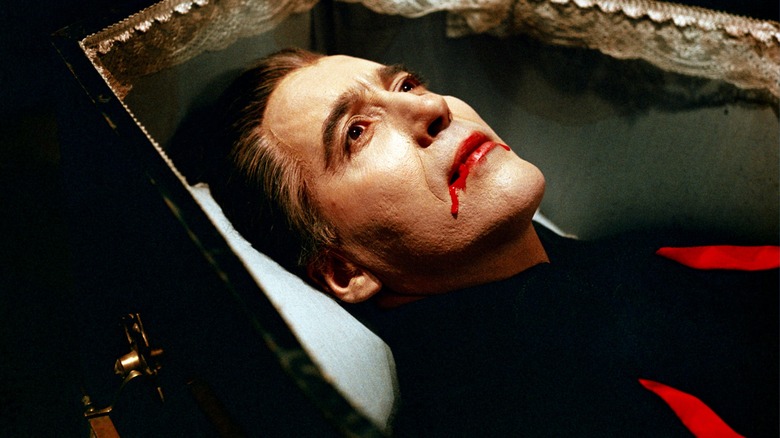
Lee's greatest asset as a performer was his voice; his baritone timbre radiated authority God himself would struggle to match. Yet, Lee had minimal screen time across the Hammer "Dracula" films. In the first, simply titled "Dracula" or "Horror of Dracula" depending on which side of the Atlantic you're from, Lee has a handful of lines in his first scene with Jonathan Harker (John Van Eyssen). He's disarmingly polite, and he never raises his tone. For the rest of the film, once his true nature is revealed, he's totally silent. In Lee's second appearance, "Dracula: Prince of Darkness," he never says a word at all. According to Lee himself, there's a simple reason for his lack of dialogue:
"I read the script [for 'Prince of Darkness'] and the lines were literally unsayable ... So I said, "I'm sorry, I'm not saying these lines, you'll get a terrific laugh,' which I'm quite convinced we would have done.'"
Lee's silence wasn't necessarily a drawback, as it made Dracula feel inhuman. Still, the actor indicated he would've been more talkative had Hammer heeded Bram Stoker's text more.
"[My lines] were not Bram Stoker. This was a great fight I used to have over the years with Hammer. I kept on saying, 'Why don't you use Stoker's words, Stoker's dialogue?' if you like. Oh no no no. So somebody used to write lines like, 'I am the apocalypse,' beyond belief."
Indeed, in 1970, Lee starred in "Count Dracula," a non-Hammer production that more closely follows Stoker's novel. He was also able to get some references to Stoker in the Hammer films. "Dracula A.D. 1972," otherwise the furthest removed from Stoker, features Lee paraphrasing the book line, "Whilst they played their wits against me — against me who commanded nations."
Why Lee Kept Doing Them
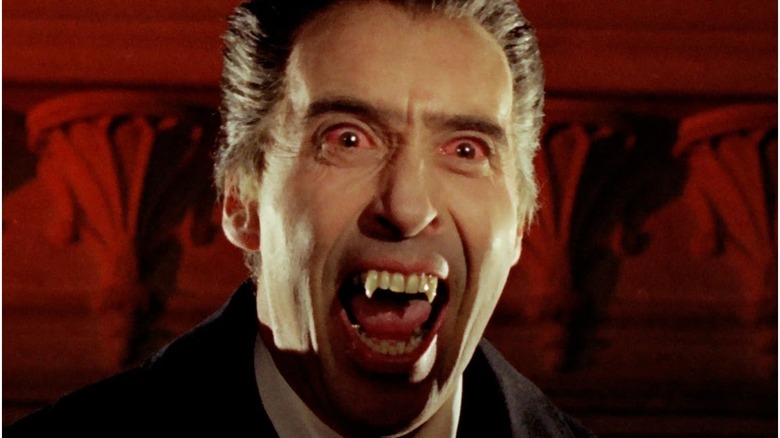
Christopher Lee's eventual antipathy toward Dracula has been well documented. Indeed, according to "A History of Horrors: The Rise and Fall of the House of Hammer" by Denis Meikle, there was a failed attempt to replace Lee and the Count in "Taste the Blood of Dracula." The original plan for the film was for Ralph Bates to play a character named Lord Courtley, who would be transformed into a vampire and assume the headlining villain role for the rest of the series. Contractual obligations necessitated Lee's return; instead of just becoming a vampire, Courtley transforms into Dracula himself.
So why did Lee keep making these movies he had no fondness for? Simple: He wasn't doing it for himself, but to help keep Hammer afloat. In an interview, he explained:
"I turned down all but the first two ['Draculas'], and here comes the crunch, 'think of the people you'll put out of work if you don't do it.' So what do I do, am I going to be responsible for putting 90-100 people out of work? Actors, actresses, directors, writers, producers, technicians, how could I? So I did them, and that is the only reason why. It certainly wasn't for money."
However, many would disagree with Lee's assessment of his own work, among them directors who Lee would work with during the 21st century. Peter Jackson and Tim Burton are confirmed Hammer fans (Burton: "'Dracula A.D. 1972.' I love that movie!"). Lee's Hammer work is what allowed for the resurgence he experienced in his twilight years. Moreover, Lee's performances as Dracula are proof that even deprived of his voice, he could still ensnare, seduce, and terrify.
Read this next: The 15 Best '70s Horror Movies Ranked
The post Why Christopher Lee Almost Never Spoke In His Dracula Movies appeared first on /Film.
Stranger Things Keeps Failing Will Byers
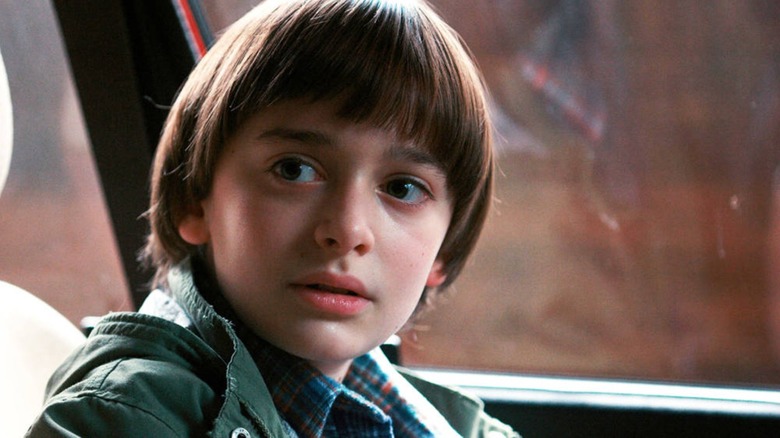
Will Byers (Noah Schnapp) has been queer-coded since "Stranger Things" began. When the sweet, sensitive kid went missing in the show's first season, school bullies joked that he was off "in fairyland," while his mom, Joyce (Winona Ryder), revealed that his deadbeat dad used to call him homophobic slurs. When Will came back from the Upside Down, he was clearly uneasy about his strong friendship with Mike (Finn Wolfhard) being displaced by Mike's romance with Eleven (Millie Bobby Brown). "It's not my fault you don't like girls!" Mike blurts out to his friend during a season three argument. The conversation doesn't go any further than that.
By season 4, Will is all but an insignificant background character. His internal emotions are completely closed off to us. We know that Eleven thinks he has a crush, that he painted something that seems to be for Mike, and that he follows his best friend and his girlfriend around with a perpetual catty scowl. Of course, there are two more episodes of the season to go, but so far, season four of "Stranger Things" has spent roughly nine hours having Will Byers do about as much as the wallpaper in the background.
"Stranger Things" is failing Will Byers, and it's also failing the fans who by this point seem to love his character more than the writers do. Viewers who identify with the young, bullied, sensitive boy have been waiting years for him to express his feelings. Instead, he seems to be trapped in a narrative closet.
The Show Hasn't Made Space For Will
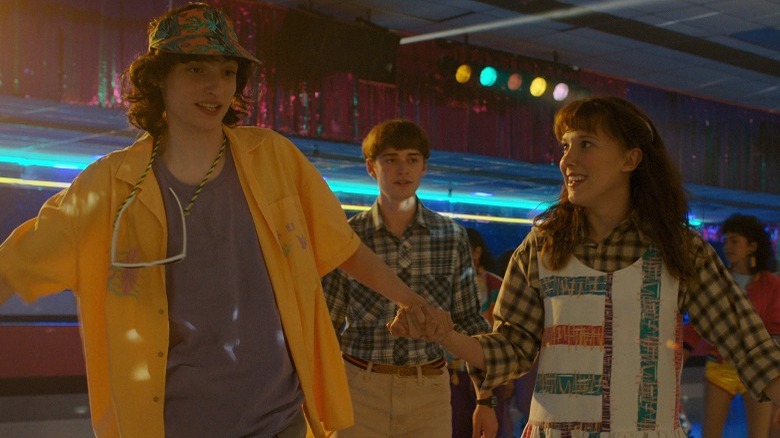
To be clear, the show doesn't owe anyone a happy ending for Will, although it would be great to see him joyful for once. It also doesn't necessarily need to fulfill the early promise of exploring his identity by having him do something as concrete as publicly coming out or getting a boyfriend. Questioning kids and late bloomers need representation too, after all.
But it would be nice to see "Stranger Things" at least try to give the character some of the interiority it lends to everyone else in its ever-growing ensemble. This season, we know more about the interests and ambitions of Dustin's long-distance girlfriend and the Russian smuggler who likes peanut butter than we do about Will, one of the show's main characters. In what appears to be an attempt to stretch out a plot related to Will revealing his lingering feelings for Mike, series writers have instead hung him out to dry.
It's disappointing that the series, which revels in all things '80s, can't seem to find a place for a queer-coded kid in its zeitgeist — and doesn't seem willing to try very hard. The '80s were an incredibly tough time to question one's sexual identity, as the AIDS epidemic forced many back into the closet out of understandable fear. But it wasn't a void for queer pop culture (pop music, in particular, was gayer than ever), and it's frustrating to see it portrayed as such. Eleven and Max get their "Material Girl" mall fashion montage. Dustin gets his Farrah Fawcett hairspray moment. Every character at one point or another seems to gain confidence and a sense of identity through something that's grounded in the show's beloved, nostalgic setting. Instead, Will gets a bad bowl cut and a wizard hat his friends think is corny. At a certain point, it doesn't feel like it's society that's excluding Will, but the show itself.
He Started As The Heart Of The Series
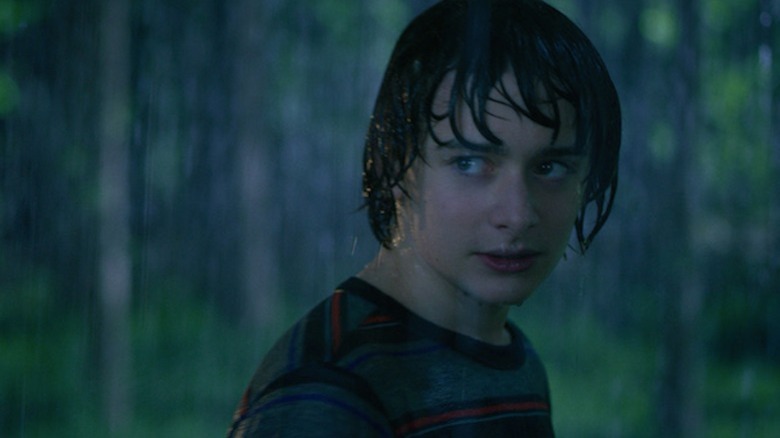
"Stranger Things" failing to let Will Byers live up to his full potential doesn't seem to be an act of malice, but of negligence. A series this massive, with this many moving parts, is bound to have a few players that start to feel like chess pieces being moved around the board. It's just a shame that Will is frequently one of them, both because Schnapp is a talented actor and because Will's story has always been a clear opportunity to illustrate the series' most important themes.
Long before Vecna's origin story was explained, it was obvious that the Upside Down pulled in outsiders. The lonely, the ill-adjusted, and the outcast always seem to end up tied to its dark power. As the first person to find himself in the Upside Down, Will embodied its metaphor perfectly. He was isolated, cut off from his sense of self and community. When he was finally saved–and then saved again, from a later manifestation of his lingering trauma — it was by the people who love him exactly the way he is.
But then Will comes back from the Upside Down, and spends the next three seasons feeling left out. The power of the show's central metaphor — of the Upside Down as the isolating void that ostracized young people can fall into — mostly dissolves. It's picked back up again as needed, like when Max (Sadie Sink) is singled out by Vecna due to her secret suicidal feelings after Billy's (Dacre Montgomery) death. The show's supersized season four finale will likely bring this idea from season one full circle, as Vecna openly preys on secrets and insecurities.
If so, that will be great, but it still won't undo the seasons the show has spent sidelining Will and obfuscating his identity. Will Byers, once the heart of this entire series, deserves better.
Read this next: Every Ridley Scott Movie Ranked From Worst To Best
The post Stranger Things Keeps Failing Will Byers appeared first on /Film.
Gary Busey's Explanation Of What Predator 2 Is About Is As Ridiculous As You'd Expect
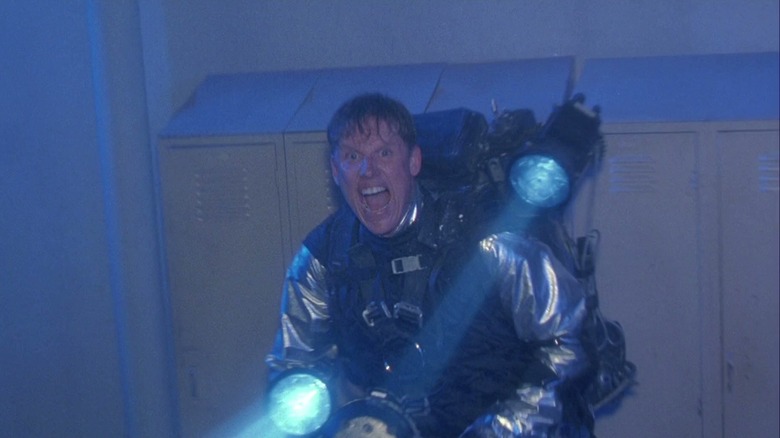
John McTiernan's 1987 sci-fi actioner "Predator" is a clever, satirical, gloriously ultraviolent takedown of military-inflected supra-masculinity. The film is populated by sweaty, muscular, weapon-fetishizing soldier types who finally encounter something they cannot merely blast out of the trees: a strong, towering, laser-armed alien game hunter who picks off humans for sport. Ultimately the film's Final Girl (Arnold Schwarzenegger) manages to best the beast, but that's not before the creature kills and/or skins all of his compatriots. "Predator" functions perfectly well as an action film, but functions even better when looked at as a satire.
In terms of its themes, Stephen Hopkins' "Predator 2" (1990) is a little less cut and dry. Set in Los Angeles in the year 1997, "Predator 2" is about an overwhelmed police force unable to contain a violent drug war all during a massive heat wave. A creature similar to the one in the first "Predator" begins stalking the various dealers involved in the war, further baffling the police, and frustrating the cartels who can't figure out who is murdering and skinning their members. Gary Busey plays a DEA agent who is, in secret, tracking down the alien. Busey's character was meant to be Schwarzenegger's from the first film, but Schwarzenegger declined to reappear.
The Battlefield Theory
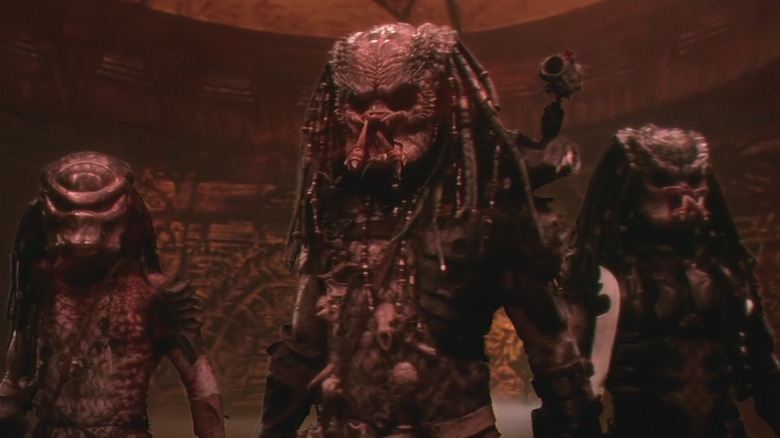
The setting of the first "Predator" was a Central American jungle and a war zone. Prior to the creature attacks, the characters were engaged in a weaponized rescue operation, and they fired hundreds of rounds over the course of it. It may be extrapolated from the setting that the alien Predators prefer hunting in said war zones. Perhaps the comment of "Predator 2" is that street crime and hot weather will become so terrible by 1997, they will be indistinguishable from war zones, thereby confusing the alien Predators. A common day in L.A. now looks the same to an extraterrestrial outsider as a battlefield.
This is a mere talking point, of course, and none of the filmmakers of "Predator 2" have gone on record with anything akin to this theory. Although, in a behind-the-scenes interview included on the "Predator 2" DVD, Busey — seemingly in character — rants about the true meaning of the Predator, why it's so dangerous, and what his character is up to. It's a little hard to follow, but Busey relates the actions of the Predator to quantum mechanics, implying that the creature has some sort of profound knowledge of the true nature of the universe.
Below is the full transcription of his explanation. Know that Busey delivered this with intensity and sincerity. It's unclear if he was meant to be in character, was simply staying in the mood of his character, or was merely trying to be as intense as possible for the cameraman filming him.
The Quantum Theory Of Gravity
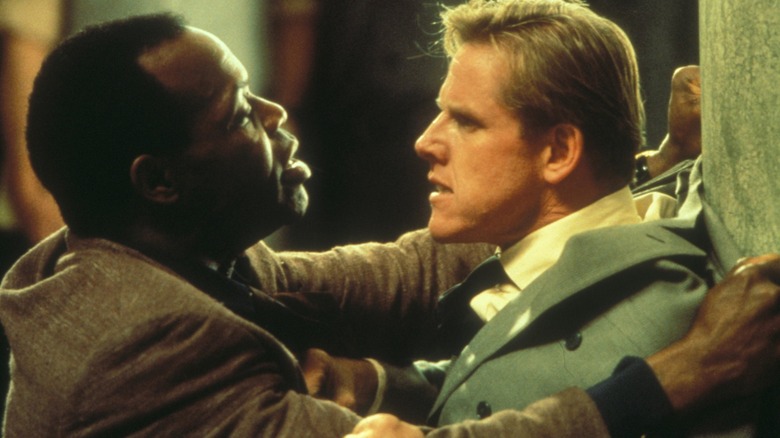
Without winking or cracking a smile, the oft-intense Gary Busey related:
"I guess you're wondering what we're doing here in these barbecue outfits. Well, it's easy. We're going in after an other-world life force from another galaxy that has a self-defense mechanism that we don't understand. It's intangible to this time and space. It's actually from the theory of relativity, and from the theory of quantum mechanics. Take those properties and then equalize them, and you have the quantum theory of gravity. Which is a discussion of how this universe started and how it will end. The Predator knows that information already. It is our job and our objective to go capture the Predator, sit him down, have a talk with him, find out why he does what he does, how he does what he does, and where he gets the weaponry and the defense mechanism he uses in order to obtain his goal. And that is our goal. If we don't achieve that goal, we will be turned into vapor clouds made of small pink particles known on Earth as blood."
The quantum theory Busey refers to involves the way gravity affects the smallest known particles. It's complicated and requires a few minutes of reading to understand. In brief, its a set of physical laws constructed to explain fluctuations in gravity that can't be defined by traditional Einsteinian physical laws, especially as it pertains to gravitons (particles of gravity) that produce their own energy and, hence, warp space in an infinite number of ways as they scatter. In order to measure such things — if spacetime is warping with every particle, no constants can be achieved and experimentation would never cease — scientists had to break space into small areas wherein spatial gravitational laws remain constant.
WTF Does This Have To Do With 'Predator 2'?
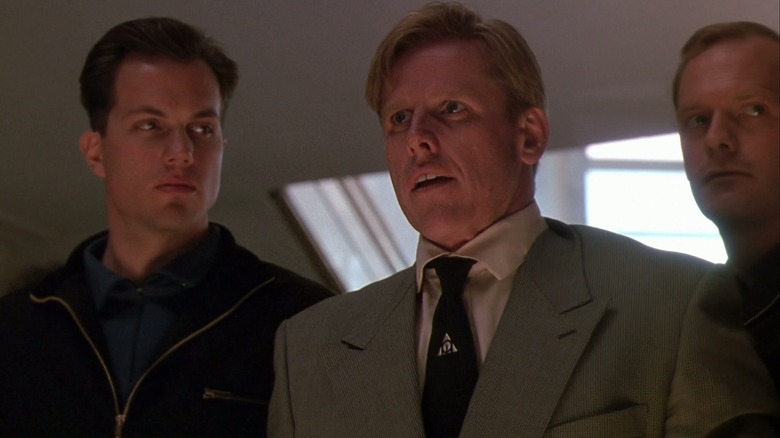
What does any of this have to do with a violent sci-fi action movie? Only Gary Busey may know for sure, but a listener may be able to connect Busey's theory to a broader sense of science fiction. Space aliens are a common sight in sci-fi stories, but the reality remains that the star closest to our sun is the low-mass Proxima Centauri, about 4.24 lightyears away. If there are aliens on one of the planets orbiting it, and they constructed a space vessel that could carry them to Earth, it could still take thousands of years to arrive. If the species in question is shorter-lived than homo sapiens, then even these technologically marvelous beings may not want to bother. This is, furthermore, based on the idea that an extraterrestrial life form would be anything like humans.
Busey doesn't bring up the Drake equation, which theorizes how many intelligent species may exist in the universe, but one can perhaps intuit his scientific rambling to mean that an intelligent being from another planet would be sufficiently advanced to know a heck of a lot more about gravitational science than we currently know on Earth. Such a being, armed with a shoulder laser, is a formidable thought indeed. I, too, would want to sit a Predator down, have a talk, and figure out more about what it knows about quantum gravity. Can the Predators measure distances smaller than the Planck length? It's not an unreasonable question.
Read this next: The 20 Best '80s Horror Movies Ranked
The post Gary Busey's Explanation of What Predator 2 is About is as Ridiculous as You'd Expect appeared first on /Film.
Bender Voice Actor John DiMaggio 'Didn't Get More Money' After Futurama Contract Standoff
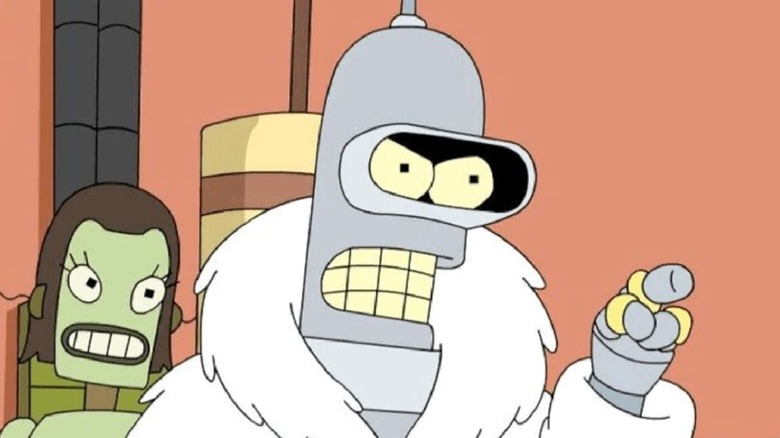
"Futurama" has been canceled and revived so many times that by now it seems like the show's eventual return is almost a given. Yet news of a Hulu continuation of the much-loved Matt Groening show hit a snag earlier this year, when John DiMaggio, who has voiced the profane robot Bender across the show's seven seasons, wasn't announced among the returning castmates.
In February, the actor explained his decision not to return in a Twitter post, saying that he believes both he and his co-stars deserve higher pay. By March, the standoff the actor dubbed #bendergate had ended, with the star closing a deal to return for the streamer's 20-episode new season after all. Fans assumed that meant Hulu met DiMaggio's request for a raise, but apparently, that wasn't the case.
/Film's Ryan Scott was in attendance at Phoenix Fan Fusion today, where a panel featuring John DiMaggio, who touched on the topic. "People are like, 'I'm so glad you got more money!'" DiMaggio said, then added, "I didn't get more money. But what I did get was a lot of respect, and a lot of head nods from people who are like, 'Yo bro, I see you and thank you.'"
The actor revealed that Hulu was set to move on with the show without him. In February, Entertainment Weekly reported that the new season was just days away from its first table read, which would happen with or without DiMaggio. At Fan Fusion, the actor told audiences that the show was "planning on using guest stars, [and] they were going to replace Bender's voice each episode," a revelation that led to groans from the audience. Luckily, that didn't happen.
'Like Trying To Get Blood From A Stone'
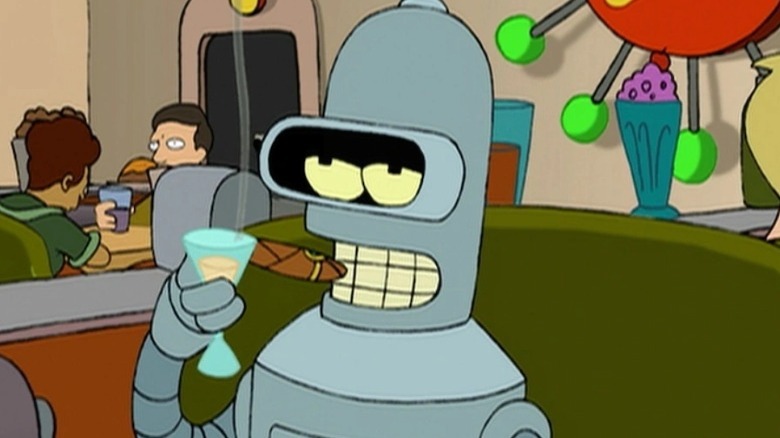
DiMaggio called the respect he got from colleagues over his fight for higher pay "quite rewarding," while adding that "trying to get money out of Disney is like trying to get blood from a stone -- you ain't gonna get it!" In a voice work industry known for lack of pay transparency and undervalued artists, the actor is surprisingly frank about the circumstances surrounding what he calls his "David vs. Goliath" face-off.
In the end, DiMaggio says it came down to a discussion with his agent over whether "we want to be in the house having a nice Thanksgiving dinner, or ... standing across the street in the freezing rain watching everybody eat stuffing." DiMaggio chose the stuffing, returning to a beloved role on a long-running series despite apparently not getting the raise he set out for. In a colorful metaphor that just about sums the whole situation up, DiMaggio says:
"But listen, this was the best thing about that fight: I had Disney, Hulu, I was holding on to their collective testicles so hard that they couldn't, y'know, there was nowhere for them to go. But there was also nowhere for me to go, and who wants to hold on to those for that long?"
Even though he ultimately decided to stop holding on, hopefully the actor's public salary negotiations will continue to inspire voice actors to speak out and demand appropriate compensation. Meanwhile, we're glad to have the infamous degenerate robot back -- with DiMaggio's voice -- for the latest installment of "Futurama."
"Futurama" will return on Hulu with new episodes in 2023.
Read this next: The Best Adult Animation Of 2021
The post Bender Voice Actor John DiMaggio 'Didn't Get More Money' After Futurama Contract Standoff appeared first on /Film.
David Harbour Says Hopper And Joyce Were Not Ready To Be Together In Stranger Things Season 3
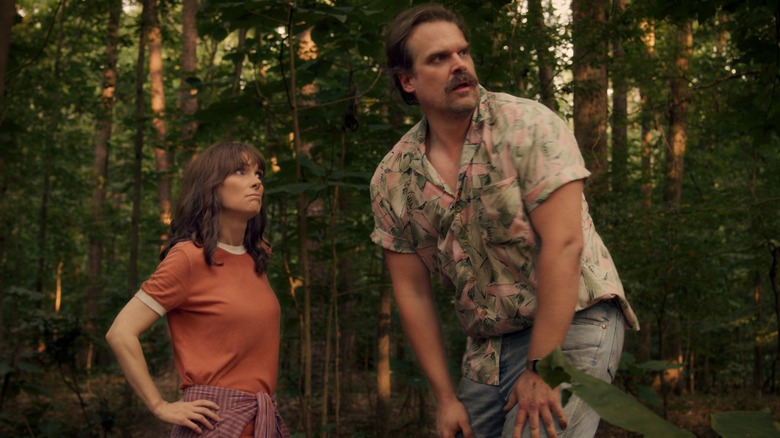
Have you watched the new episodes of "Stranger Things" yet? Even if you haven't, you likely know the fourth season finds ex-police chief Jim Hopper (David Harbour) alive but not exactly well, fighting for his life in a Russian prison. The character's supposed season 3 death apparently didn't take, as the character's true fate was revealed way in advance of the new season.
But according to Harbour himself, Hopper's season 3 flirtation with former high school flame Joyce (Winona Ryder) couldn't have had a happy ending, even without the Upside Down getting in the way. "I certainly feel like, from what happened in season 3, it couldn't work," Harbour told Variety. "The guy from season 3 and woman from season 3 could not work."
The actor revealed that he and Ryder have their own theories about the couple's future: "Winona and I postulate a bunch of stuff, we have a bunch of theories. Some of them are very wild, and some of them are very tame." The actor says that the team behind the show has mapped out the direction they want the couple to head in, but that he sees their love as a lot more complicated than a simple romance.
They Love Who They Used To Be
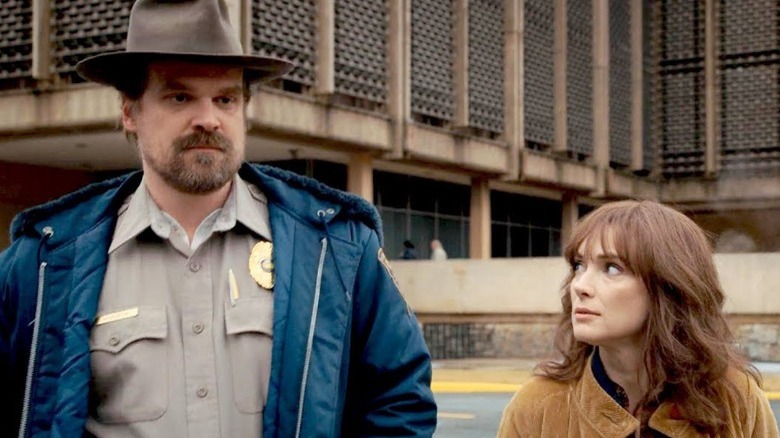
"They knew each other when they were super innocent, and they had all this potential, both of them. Now they don't have much potential," he says, referencing the couple's high school near-romance and the paths their lives have taken since. The way the actor sees it, the pair's love is based on being able to see one another for both what they are–failures and all–and what they used to be to each other. "Knowing someone who, when you look in their eyes, you see that young person they were, is part of the bond between the two of them."
Despite what Harbour calls their "complex love," he seems to think the Hopper and Joyce of last season still had some work to do on themselves. "Clearly there's some chemistry and there is a longing for them to be together," he says in reference to season 3, "but they would they would have to become different people."
Luckily, they've been doing just that across the new season's first seven episodes. In Russia, Hopper's life has become cold, painful, and scary, but it's also made him reflect on his deepest wounds, like his time in the military and his daughter's death. Meanwhile, Joyce is braver than ever, negotiating with shady smugglers and even surviving a plane crash.
So does Harbour think Joyce and Hopper should end up together by the end of the show's fifth and final season? He's leaving it up to the showrunners, saying the Duffer Brothers get to decide whether "they need to live happily ever after" or "suffer in silence." With respect to Harbour's tragic take on the couple, we're hoping for the happy ending.
"Stranger Things" season 4, volume 1 is now on Netflix. The last two episodes of the season will drop July 1, 2022.
Read this next: The 15 Best Netflix Original Series Of 2021 Ranked
The post David Harbour Says Hopper and Joyce Were Not Ready To Be Together in Stranger Things Season 3 appeared first on /Film.
The Movies And Shows That Inspired Stranger Things Season 4
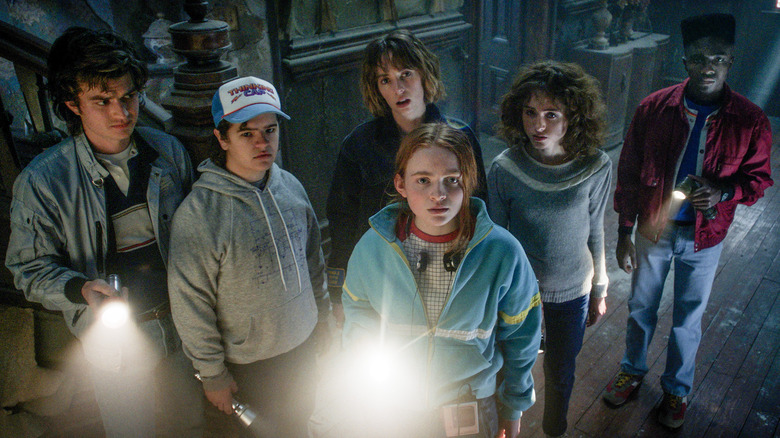
"Stranger Things" season 4 has arrived, and we're starting to see things upside down. Obviously, the first three seasons were inspired by a whole lot of TV shows and movies from the 1980s, and this season is no different. From teen romances to horror flicks, there are so many nods to the media we loved back when hair was huge, and colors were fluorescent (and even a few that came after). Before we start, here is a look at the synopsis for "Stranger Things" season 4 Vol. 1, which is episodes 1-7:
It's been six months since the Battle of Starcourt, which brought terror and destruction to Hawkins. Struggling with the aftermath, our group of friends are separated for the first time – and navigating the complexities of high school hasn't made things any easier. In this most vulnerable time, a new and horrifying supernatural threat surfaces, presenting a gruesome mystery that, if solved, might finally put an end to the horrors of the Upside Down.
Needless to say (or it should be needless), there will be spoilers ahead after the trailer. Turn back if you haven't watched yet, or Vecna will getcha!
Back To The Upside Down
Films set in high school in the 1980s featured a lot of bullying by the popular crowd. Eleven (Millie Bobby Brown) is certainly on the receiving end of bullies in her new California school, when she shows her diorama in class, in the schoolyard after the incident, and later at the roller skating rink. It's pretty cruel, and reminds us of moments in "The Breakfast Club," when Brian (Anthony Michael Hall) talks about what being bullied by the jocks did to him, leading him to bring a gun to school. Eleven doesn't have a gun, but she does try to use her powers in the schoolyard on her bullies, and later hits one in the face with a roller skate.
"The Breakfast Club" character Bender (Judd Nelson) is clearly an influence on Dungeon Master Eddie (Joseph Quinn). Eddie, like Bender, covers up his pain with bravado. Eddie is a bit of a jerk when we meet him at first in the cafeteria, but once the layers are peeled away, we realize that he's had it pretty rough. There is clearly an influence from that film on the scene where the cheerleader Chrissy (Grace Van Dien) — Vecna's first victim in this killing spree — and Eddie get to know a little about each other, recalling when they'd spoken once, years before. If Vecna hadn't intervened, the scene might have played out the way Claire (Molly Ringwald) and Bender's does, with them finding common ground, and possibly a connection.
High School Drama
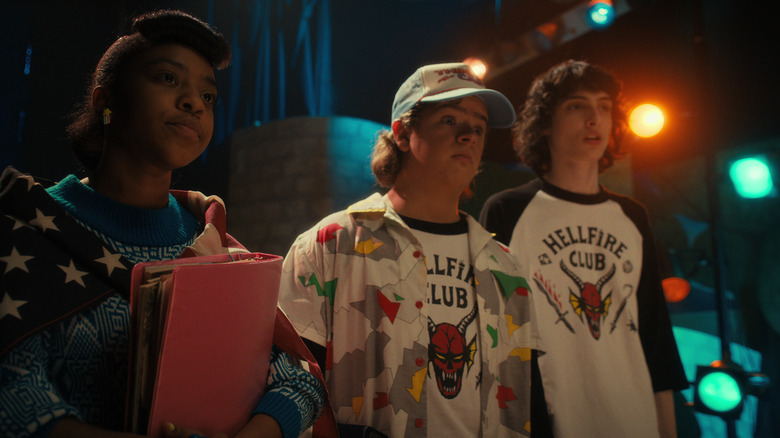
In "The Breakfast Club," the kids break into the principal's office to read their school records. In "Stranger Things," Max (Sadie Sink) steals her guidance counselor's keys, and the kids look at school records to see what the murdered children have in common; headaches, past trauma, and nightmares. There is also the makeover scene when Nancy (Natalia Dyer) dresses Robin (Maya Hawke) up as a college student and Robin not being able to walk in heels reminds me of the scene where Claire gives Allison (Ally Sheedy) a makeover in the bathroom.
"Ferris Bueller's Day Off" is a clear influence when Dustin's long-distance girlfriend Susie (Gabriella Pizzolo) changes his Latin grade with her computer, and that's something Ferris (Matthew Broderick) does for himself with absences. The computer even looks very close, visually. Even having a smart and sarcastic younger sister (and I don't mean that in a bad way because first, Erica (Priah Ferguson) is awesome, and second, Ferris is a jerk and his sister — Jennifer Grey — is way cooler) is very "Ferris."
Though there isn't a specific moment, and I'm speaking more in terms of a feeling, stoner buddies Argyle (Eduardo Franco) and Steve (Joe Keery) give off some "Dazed and Confused" vibes.
Brenner (Matthew Modine) telling Eleven that monsters don't exist after we've been watching them in a show for four seasons reminded me of Wesley (Carey Elwes) in "The Princess Bride" saying that ROUSs (rodents of unusual size) don't exist right before he gets attacked.
Adventure Stories
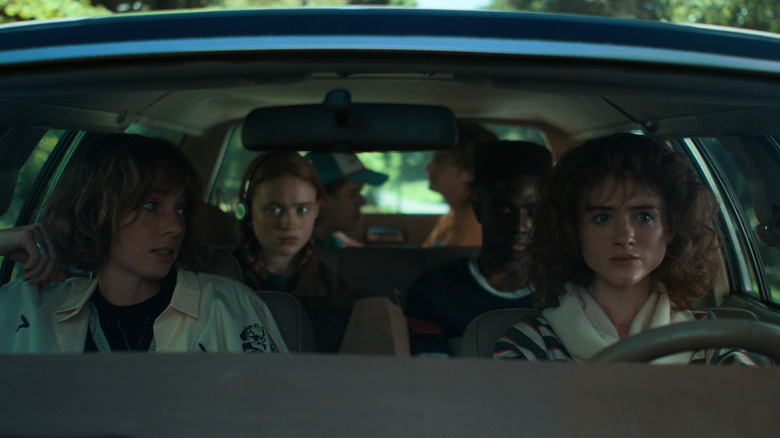
The first "Star Wars" trilogy had been out for a few years by the time season 4 takes place, so there is no surprise when we hear Dustin (Gaten Matarazzo) quote from "Star Wars: Episode V — The Empire Strikes Back," saying, "Never tell me the odds," like Han Solo (Harrison Ford) does in the Dungeons & Dragons game with the Hellfire Club.
Speaking of "Star Wars," in episode 7, when One (Jamie Campbell Bower) says, "Join me" to Eleven, it definitely felt like Darth Vader (James Earl Jones) speaking to Luke Skywalker (Mark Hamill), trying to turn him to the dark side towards the end of "Return of the Jedi." Plus, One and Eleven hold their hands out like they're having a Force battle, which they sort of are.
Eleven lying in the water in the sensory deprivation tank gives off "Minority Report" vibes, especially since she's working with psychic powers. In that film, the precogs do the same to discover crimes before they happen. Eleven is discovering the truth of a crime that she thinks she committed in the past.
Scary Stuff
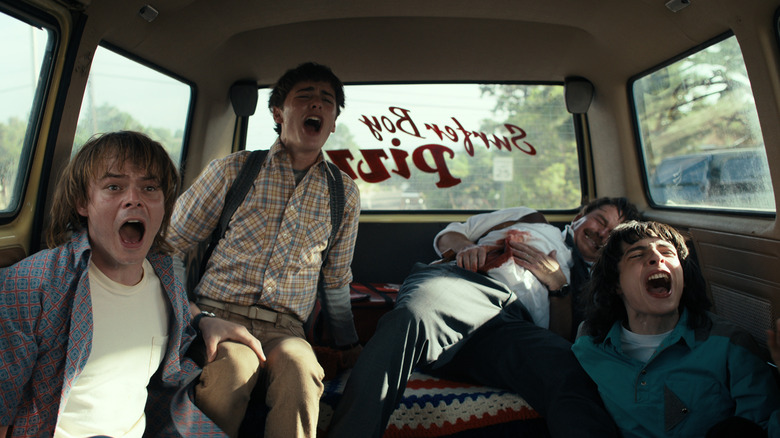
There are a whole lot of horror influences here, which makes total sense. Horror films of that time did tend to punish (kill) kids with a past, or who did things they weren't "supposed to." That's been a thing since the first seasons, but here it's kids with trauma instead of just kids who have sex.
"Carrie" comes to mind because of the roller rink scene with Eleven bashing Angela's (Elodie Grace Orkin) face with the skate. In "Carrie," the continual bullying of the main character, ending with a public prank where she's covered in pig's blood at the prom was very much an influence on Eleven's story. Eleven is bullied, and then subjected to a very public prank at the rink where they film her, covered in a chocolate shake, surrounded by other kids who are taunting her. Eleven isn't covered in blood after the prank, but Angela is, and it was her bullying that finally sent Eleven over the edge.
Freddy Krueger from "A Nightmare on Elm Street" is actually mentioned outright, which is fun because Freddy himself, Robert Englund is playing Victor Creel in the series. They even mention his boiler room, though the creepy place in the Creel house is the attic. Freddy affecting the dreams of his chosen teen victims is paralleled in "Stranger Things" as the kids with past trauma are having terrible nightmares, which are affecting their waking lives. The flashing lights and ghost vibes from "Poltergeist" are all over this season, as they were in the past seasons.
Don't Cross Vecna
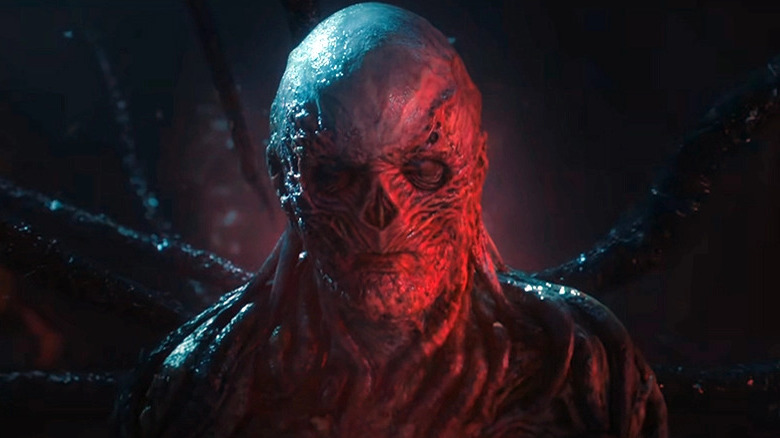
Robin and Nancy visit a prison for the criminally insane to meet with convicted murderer Victor Creel. Clarice (Jodie Foster) did the same with Hannibal Lecter (Anthony Hopkins) in "The Silence of the Lambs. There are moments as the young women walk down the hall and are subjected to leers from the other prisoners the same way (though not as graphically) as Clarice was.Vecna himself, though we haven't seen the endgame, does have a very Pennywise (Bill Skarsgard) or Pinhead (Doug Bradley) sort of vibe to him, and the Duffer Brothers said as much in an interview with IGN. He's also got a very "Game of Thrones" Night King (Richard Brake) vibe to him. Honestly, the whole being hooked up to tentacles for power puts one in mind of the Emperor (Ian McDiarmid) in "Star Wars: The Rise of Skywalker," when he is finally revealed. He's hooked up to something giving him power as well.
"Stranger Things" season 4, episodes 1-7 are now streaming on Netflix. The final two episodes will hit the streaming service on July 1, 2022.
Read this next: 14 Sequels That Truly Didn't Need To Happen
The post The Movies and Shows That Inspired Stranger Things Season 4 appeared first on /Film.
You Should Know How to Hang a Hammock

Now that summer’s almost here, it’s time to enjoy the great outdoors. Instead of relaxing inside on the couch, you can relax outside, slowly rocking in a hammock. But if you’ve never put up a hammock before, you may find the process a bit intimidating—which is totally understandable, given that it’s basically a net or…
RPG Codex Review: Jupiter Hell
How to Fix the Epic Games Launcher's High CPU Usage on Your Windows PC
Epic Games Launcher is a digital distribution platform for all your games bought or downloaded from the Epic Store. However, you might sometimes notice the launcher consuming a lot of system resources.
Algorithms in Videogames Criticized for Choosing Fairly-Matched Opponents
Read more of this story at Slashdot.
The 30 Scariest Horror Movie Monsters Ranked
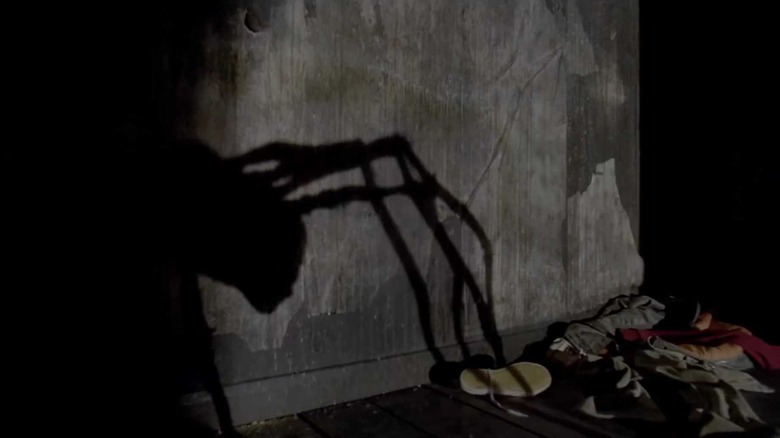
What scares you? Is it something ephemeral, like the concept of death or failure? Do sharks and slithery things give you nightmares, or is it Freddy Krueger and Michael Myers who keep you up at night? In the realm of terrifying monsters, it's hard to pick the absolute scariest one. Fear is, after all, purely subjective. Many things go bump in the night, but not all of them are created equal. Sure, some monsters will stick with you from childhood until you're old a grey, but others ... well, they lack a certain Je ne sais quois. Not these ones, though. No way.
The /Film horror team put their heads together to come up with an immense list of horror movie monsters that gave them the frights, and together they whittled that list down to 30 contenders. Here are your scariest horror movie monsters.
The Overlook Hotel
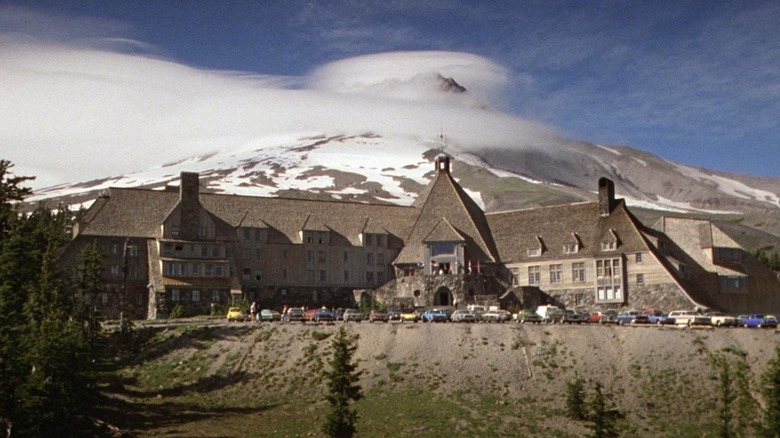
Stephen King is known for a prolific career full of terrifying monsters. One of his most iconic and terrifying creations was The Overlook Hotel. The Overlook first graced the pages of King's 1977 novel "The Shining" before its 1980 feature film debut. When troubled writer Jack Torrence moves his family into the Overlook as its winter caretaker, he soon discovers that the hotel is full of predatory spirits of deceased guests. What's worse, it wants to corrupt Jack in an effort to take his son Danny because of his nascent psychic abilities.
The Overlook isn't merely a haunted hotel, it's a sentient being with malicious desires and intent. It also happens to be able to corrupt its guests and ensnare them forever. What really drives the terror home is the fact that its horrors are completely personal, using Jack's alcoholism and isolationist tendencies to turn him against his own family. It's a sentient, corrupting hotel that knows its victims and weaponizes their deepest weaknesses against their loved ones in a cycle of blood and death. Few things are scarier. (Jeff Ewing)
The Man With Fire In His Face
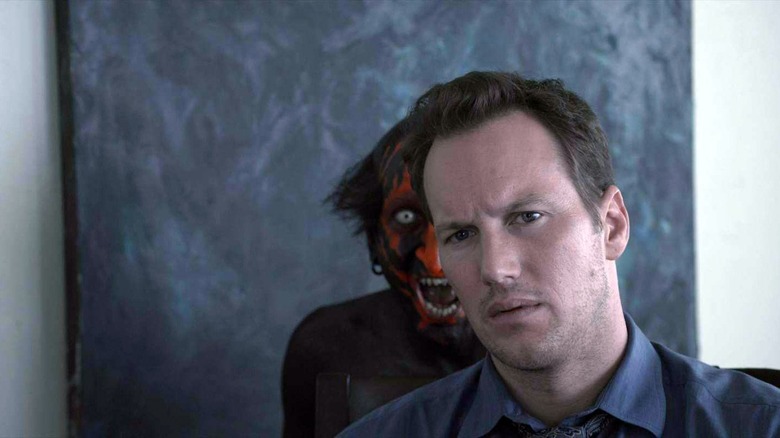
James Wan has created countless monsters throughout his career, but "Insidious" introduced one of his mightiest. The Man With Fire in His Face, aka Lipstick-Face Demon was an instant frightener when the first "Insidious" trailer played. As the minutes-long teaser plays out, we see glimpses of Lin Shaye as a medium, Rose Byrne as a family protector, and then Patrick Wilson's face — at first. Behind Wilson's father figure seated at the dinner table leers Wan's Darth Maul wannabe, peering into the camera, taunting Wilson from behind. You needn't even see "Insidious" to fear the demon, thanks to possibly the most iconic horror trailer moment of the last decade.
As a resident of The Further, Red-dy Krueger "seeks to bring pain and chaos to the world of the living by possessing a human body." He's distilled hatred with a snarling face, designed like he's the dictionary definition of "Satan's Little Helper." The demon lures Dalton Lambert (Tyler Simpkins) into his lair, chains the boy down, and tortures him to his heart's ill content.
"Insidious" is crammed with tremendous scares, so many due to the demon's daunting stalks as even his blackened figure brings that added spike of anxiety. Once you see the red face, you'll never sleep again. (Matt Donato)
The Predator
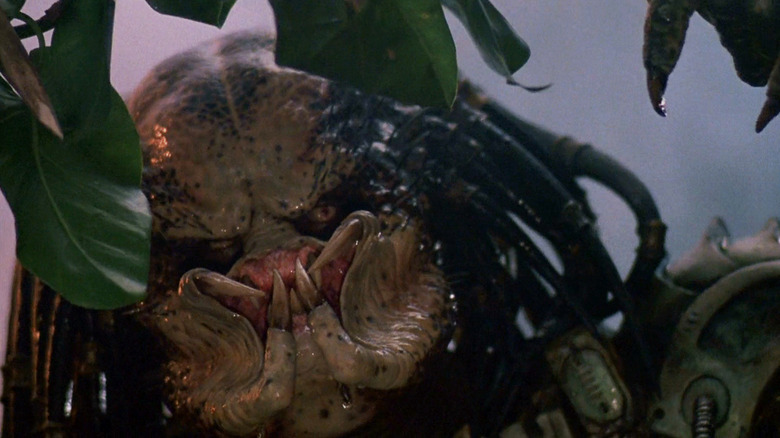
The Predator has been through quite a few iterations over the years. Some of them are scarier than others, but none of them hold a candle to the original from 1987's "Predator." Arnold Schwarzenegger stars in the film directed by John McTiernan about a group of special forces commandos who go into the Central American rainforest to rescue hostages from guerrilla forces. Unfortunately, they also encounter the Predator, an alien warrior who travels from planet to planet, hunting the universe's most dangerous prey.
The original Predator was played by Kevin Peter Hall in a monster suit. Initially, the Predator appears to have a smooth, metallic face, but this is revealed to be a helmet. He's actually got some mega mandibles and a whole lot of razor-sharp teeth under there. He's terrifying because he's the galaxy's greatest hunter, with cloaking capabilities and lots of practical battle skills. He can be pretty cool when he's on your side, like in the "Aliens vs. Predator" series, but it's never good to be his prey.
Fans of the series will get a chance to see that in action in Dan Trachtenburg's prequel film, "Prey." (Danielle Ryan)
King Paimon
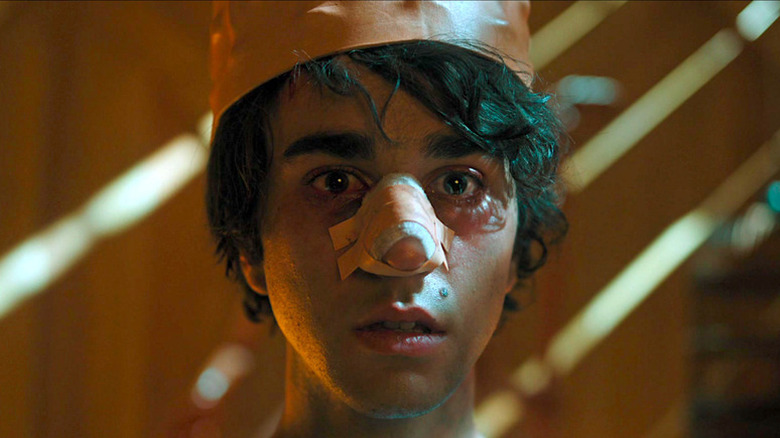
One of the scariest monsters in 21st-century horror never shows its true face. Still, the spirit of King Paimon lingers in the dark and quiet terror of every moment of "Hereditary." Ari Aster's feature debut coats the air with a choking sense of wrongness from early on in the movie and lets the dread of Paimon's unseen force escalate into a wild and horrific climax. Audiences will have forgotten to breathe by the time Alex Wolff's Peter flings himself through a window and shuffles, possessed, into his treehouse shrine.
"Hereditary" makes Paimon terrifying by refusing to explain him, instead offering clues and details leading up to the final, gruesome revelation that the family's tragedies have all been in honor of the dark deity. Viewers don't know exactly what he wants, or why, but it's clear that he gets it by causing deep hurt and tremendous fear. The fact that his manipulations feed on situations that can happen to anyone, like mental illness, accidents, aging, and death, makes Paimon's power all the more frightening. (Valerie Ettenhofer)
Clover
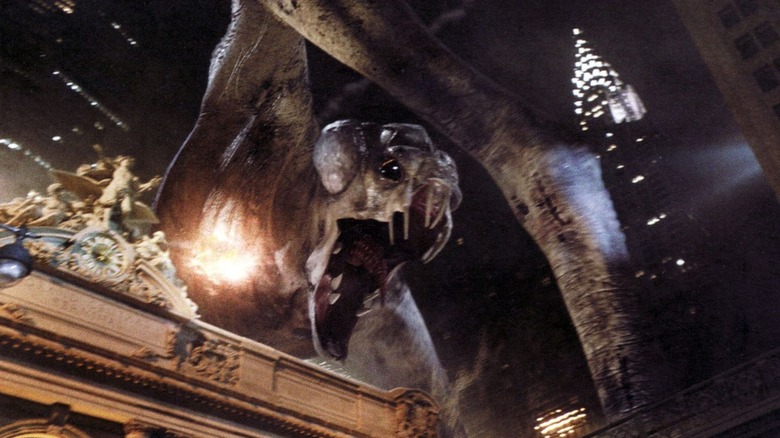
American Kaiju cinema isn't as popular as it should be, which is a shame because "Cloverfield" is such a phenomenal experiment in perspective and destruction. The title references Project Cloverfield, which the American government uses as a codename for the film's creature. An extraterrestrial beast crashes into the ocean and begins destroying New York City, which we witness through the found-footage perspective of partygoers now fleeing for their life.
There's no defense, and nowhere you can escape given the Kaiju's gargantuan size. How is that not pit-of-your-stomach horrific?
Let's cover all the ways Clover — the eventual nickname of the mega beast — can cause harm. Maybe his gigantic stomper crushes you underfoot, or perhaps he chews you in half. Clover could topple a skyscraper or bridge and crush you under debris. The helpless feeling that "Cloverfield" stirs is the ultimate horror vibe, and that's without even acknowledging the violent minions Clover releases from its body that causes victims to explode when bit.
Clover is one of the great American monsters since Y2K, causing a million ways to die that we will never forget. (Matt Donato)
Regan MacNeil
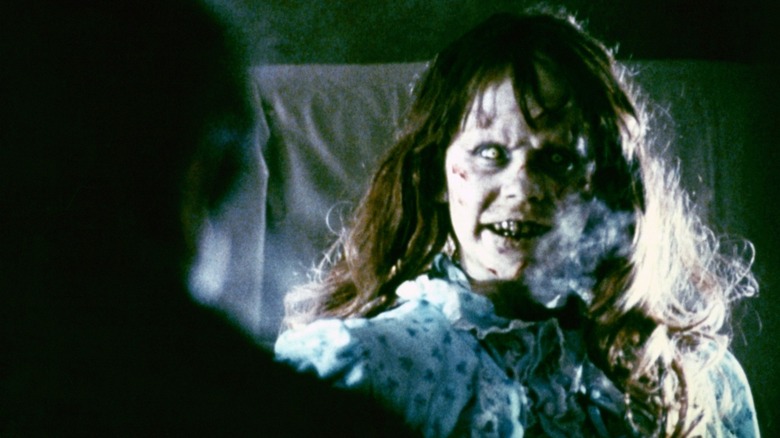
Often dubbed one of the scariest movies of all time, "The Exorcist" caused fainting spells, walk-outs, and shudders of disgust when it premiered theatrically in 1973. Archival footage of audience reactions at the time shows that people were far more scared of Regan MacNeil (Linda Blair) than her possessor, Pazuzu. "She turned her head around," one young woman stuttered in horror after leaving the screening, immediately hiding her face in her date's jacket. Even the mere mention of the scene was too horrifying to handle.
It makes perfect sense why a 12-year-old girl, covered in neon-green vomit and with blood oozing from every orifice, continues to inspire nightmares as opposed to the stony-faced Pazuzu. Something seemingly harmless and gentle is transformed into an inhuman threat, her demonic voice change and physical contortions an affront to human nature itself. She is at once innocent and corrupted, and there's no concrete explanation as to why she was marked for possession. This is what's truly so terrifying about Regan: If the Devil chose her to be his vessel, what's to say he can't claim you?
Forget Catholic guilt — "The Exorcist" is the ultimate example of Catholic anxiety. (Natalia Keogan)
Graboids
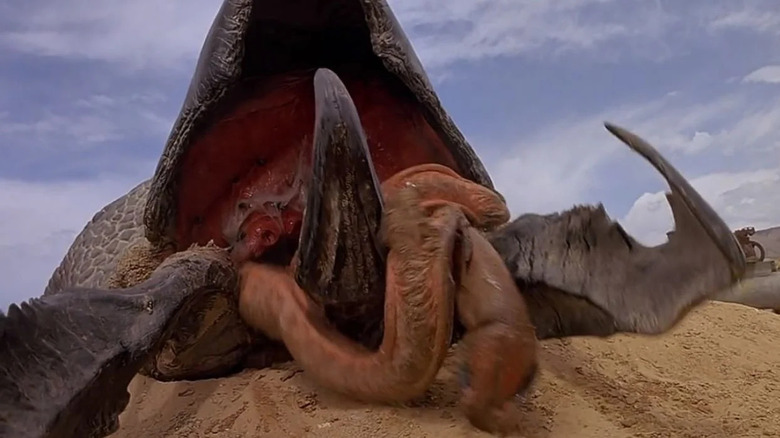
Ron Underwood's classic 1990 creature feature, "Tremors," achieves an incredible feat: making 'roided-out earthworms threatening.
Originally theorized as extraterrestrial — "I vote for outer space. No way these are local boys," says Earl Basset (Fred Ward) — the sightless underground monsters, also called the unimaginative "Dirt Monsters," are discovered to be prehistoric rabble-rousers who like to eat livestock, cars, and the occasional bit of human flesh as a treat. Their snake-like appendages are strong enough to hold a running truck back from escape, and they are patient enough to lay siege to their potential lunch for days on end. When they descend upon the high desert, mountain-bound town of Perfection, Nevada, it's an all-you-can-eat buffet: sensing the vibrations humans make (walking, bouncing on a pogo stick, dribbling a basketball, etc.), it's easy for the creatures — dubbed "graboids" by store owner Walter Chang (Victor Wong) — to spot their next meal.
But there's one thing they don't count on: a pair of aimless handymen (Kevin Bacon and Ward), a seismologist, and a Republican prepper couple with way too many firearms. (Anya Stanley)
Godzilla
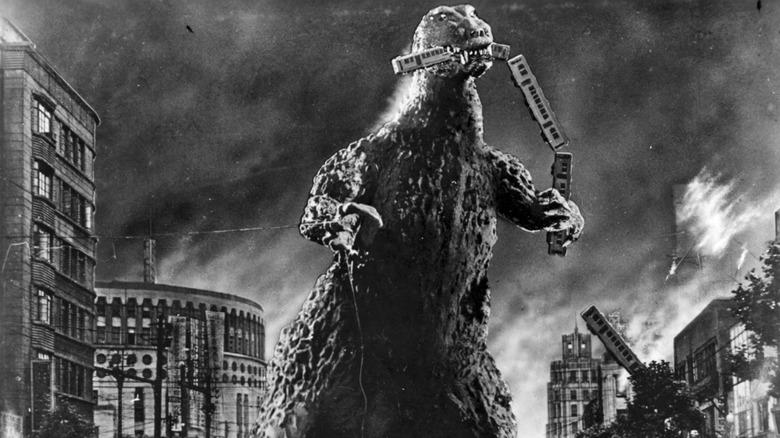
Godzilla is one of the most iconic and enduring monsters in the history of cinema. He's also right at home on this list as one of the most terrifying.
Ishirō Honda's 1954 masterpiece was born from the anti-nuclear movement following World War II and the H-bomb testing at Bikini Atoll, with the titular kaiju serving as a stand-in for Japan's well-founded fears of nuclear annihilation. After the war ended, the U.S. military occupied Japan and essentially banned all press coverage of the aftermath of Hiroshima and Nagasaki, hiding the catastrophic fallout from the rest of the world. Though the occupation ended in 1952, the U.S. military used the Marshall Island of Bikini Atoll well into 1954. This would become the site of the most powerful nuclear bomb ever detonated by the United States: Castle Bravo.
And thus Godzilla was born. His skin was designed after the keloid scars covering the bodies of Hiroshima survivors, and his atomic breath wreaked the same havoc on the people of Japan that the U.S. military had subjected them to. The film opens with a haunting homage to the Lucky Dragon No. 5, the first casualty of Castle Bravo, only Godzilla ensured they never made it home.
Godzilla remains an indelibly horrifying creature not because of his size or appearance, but because of the history that created him. It's just that simple. (Ariel Fisher)
Crawlers
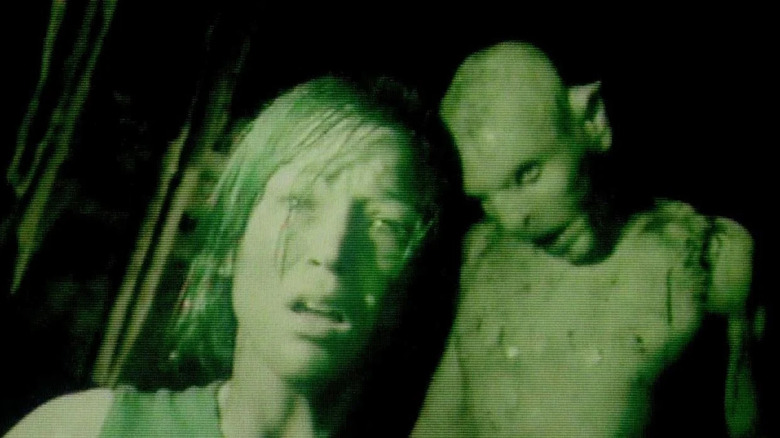
"The Descent" is one of the 2000s greatest horror triumphs. Y'all wanna explore caves with claustrophobic passageways? Be my guest. Shimmy your way around stalagmites and venture into pitch-black unknowns at your own peril because you might find imp-like, feral beasts that toss bones picked clean of flesh into a bloody pool.
Neil Marshall's Crawlers are a species of humanoids who've evolved underground, physically adapting to the landscape of subterranean cave systems. Their ears are pointed, noses rigid and flat against faces like a bat, exhibiting nocturnal traits on top of their predatory instincts. Crawlers scale walls, hunt using echolocation, and don't need flares to see. The way Crawlers scamper, gliding across slippery rock faces that would cause veteran spelunkers to pause, is enough to make you stay away from any cave entrances.
Sarah (Shauna Macdonald), Juno (Natalie Mendoza), and their friends are no match for the creatures that view the humans as invaders, as Crawlers chew, chase, and massacre them with ease. (Matt Donato)
Brundlefly
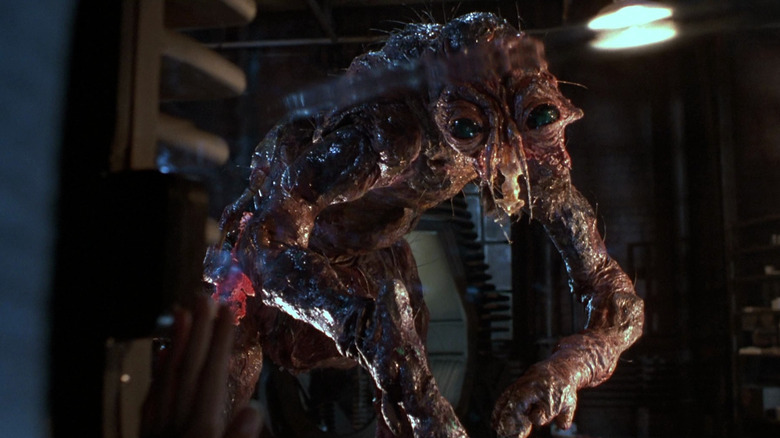
Remaking a classic horror movie is one of the biggest risks a director can take, but for David Cronenberg, "The Fly" helped solidify his reputation as one of horror's greatest masters.
"The Fly," a remake of the beloved B-movie of the same name, showcases the revolting demise of Jeff Goldblum's Dr. Seth Brundle, a brilliant scientist who believes he has discovered the key to teleportation. In what would become quite possibly the biggest drunken mistake ever put to film, Dr. Brundle attempts to test his telepods on himself, unknowingly merging himself with a housefly in the process. The results are grotesque, as Dr. Brundle slowly transforms into the monstrous creature known by horror fans as Brundlefly. His body mutates and falls apart, growing increasingly more repulsive by the hour.
Thanks to the Academy Award-winning practical makeup work of Chris Walas and Stephan Dupuis, the unsightly vision of Jeff Goldblum's metamorphosis has been effectively terrifying (and grossing out) audiences for nearly four decades. (BJ Colangelo)
Count Dracula
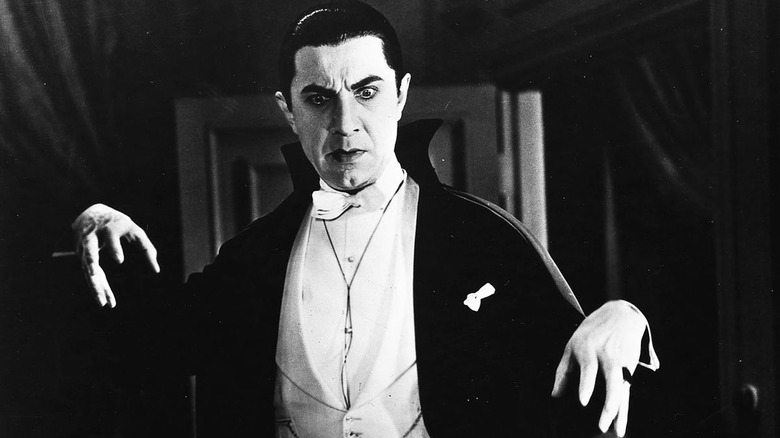
As Bela Lugosi famously said as the vampiric Count Dracula, "There are far worse things awaiting man than death." The legacy of the Universal Monsters films spans nearly a century, but it all began with the vampire classic, 1931's "Dracula."
The true terror of Bela Lugosi's performance as the Count is not in jump scares or dramatic makeup effects, but rather in how undeniably electric he is on screen, able to successfully lull us into his trap with a well-placed smile and the delicate raise of an eyebrow. His vocal pattern has become the default for what Count Dracula should sound like, providing the perfect combination of creepiness and captivation.
The character has been reinterpreted by a multitude of actors including Christopher Lee, Lon Chaney Jr., Gary Oldman, and even the puppeteers on "Sesame Street," but Bela Lugosi is the defining Dracula who paved the way for all future bloodsuckers and children of the night. (BJ Colangelo)
The Tentacle Monster
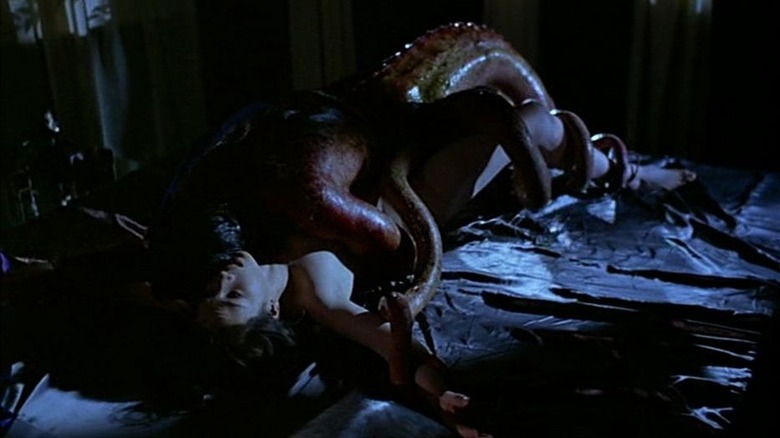
Andrzej Żuławski's psychological horror drama "Possession" is a film that feels as if it defies description. Better suited as an experience rather than something to watch, "Possession" tells the story of Sam Neill's Mark, a spy who upon realizing his wife, Anna (played by Isabelle Adjani) is seeking a divorce, is thrown into a world of nightmarish psychosis as he slowly uncovers the truth of his wife's infidelity.
The film was banned in many places upon its release in 1981, due in large part to the way horror and sexuality are visually intertwined throughout. "Possession" is a film as horny as it is horrific, with Adjani's Anna seeking the pleasure not of a random lover, but of a gooey, gruesome, tentacled monster. The creature is given minimal screen time, but the image of it writhing on top of her is enough to sear itself into the subconscious of anyone watching. The monster's impact on both Anna and Mark inspired two of the most grueling performances in horror history.
Life gets pretty weird after you do the dirty deed with a gigantic tentacle beast. (BJ Colangelo)
The Possum Marionette
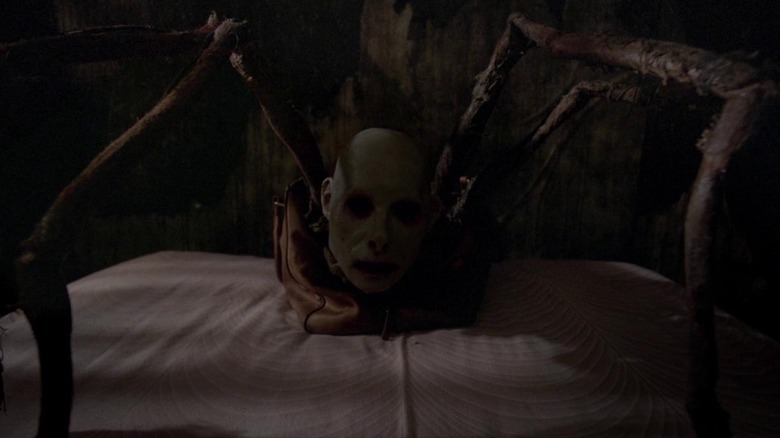
"Possum," the depressing, psychological horror film directed by Matthew Holness, who cult horror fans may know as the creator and star of, "Garth Marenghi's Darkplace," tells a story as disturbing as the terrifying puppet monster that gives the film its title.
The story follows a disgraced children's puppeteer named Philip Connell (Sean Harris) who is forced to revisit his childhood home where his feeble uncle now resides. The only bag he brings on his journey is a leather duffel bag that houses a spider-like marionette called Possum that continually haunts Phillip throughout his visit. He tries to discard the puppet, but no matter what he does, Possum seems to make its way back to him. For most of the film, only the puppet's massive spider legs are visible, making the reveal of the spider's human face all the more horrific.
More than just a mere marionette, Possum is the manifestation of Phillip's disturbing past, and its grotesque appearance is a direct reflection of his anguish. (BJ Colangelo)
Moder
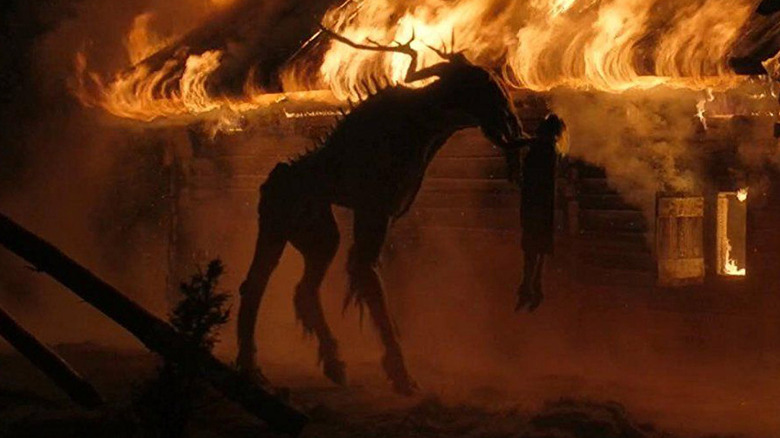
David Bruckner's "The Ritual" is about a lot of things like toxic masculinity, the pain of growing apart from your friends, and the dangers of camping, but it also happens to feature one of the coolest original creature designs in recent memory.
After a group of friends played by Rafe Spall, Arsher Ali, Sam Troughton, Robert James-Collier, and Paul Reid go on a trek into the woods, they discover an ancient evil, a kind of Norse giant called a Jotunn. One of the friends completes a pagan ritual and manages to summon Moder, a Jotunn whose spirit is tied to that particular forest and happens to be the ill-gotten son of Loki, God of Mischief. That's when things get really interesting.
Moder is a horrifying creation. He's part stag and part human corpse, with a man's torso for a face, and arms hanging down below his mouth like a warthog's tusks. He's also huge, towering high into the trees.
"The Ritual" is a slow-burning nightmare, but once Moder shows up in his gory glory, it's well worth the wait. (Danielle Ryan)
Michael Myers
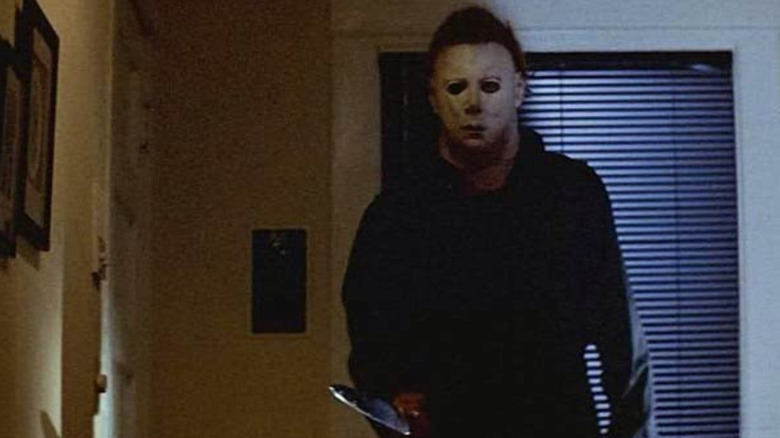
This entry really only needs three words: he's the Boogeyman. Michael Myers holds an esteemed place in the horror baddie pantheon by virtue of being one of the earliest and simplest slasher icons — pre-Jason Voorhees, pre-Freddy Kreuger.
Originally titled "The Babysitter Murders," John Carpenter's 1978 film "Halloween" established the coverall-wearing, blade-wielding killer as a silent, stalking force of evil. "The Shape," as he's known in Carpenter and Debra Hill's script, killed his older sister on Halloween night of 1963 when he was a child, and following a lengthy stay in a mental institution, Michael escapes and returns to Haddonfield for more slicing and dicing.
Stare into his shock-white mask to see what Dr. Loomis (the Ahab to the elusive Myers' white whale) called "the blackest eyes, the Devil's eyes." Few have gotten that close and lived to tell the tale, though.
Only appearing on one night of the year in one specific town, but so un-killable as to prompt a slew of sequels and re-quels, Myers is more myth than man at this point. (Anya Stanley)
Valak
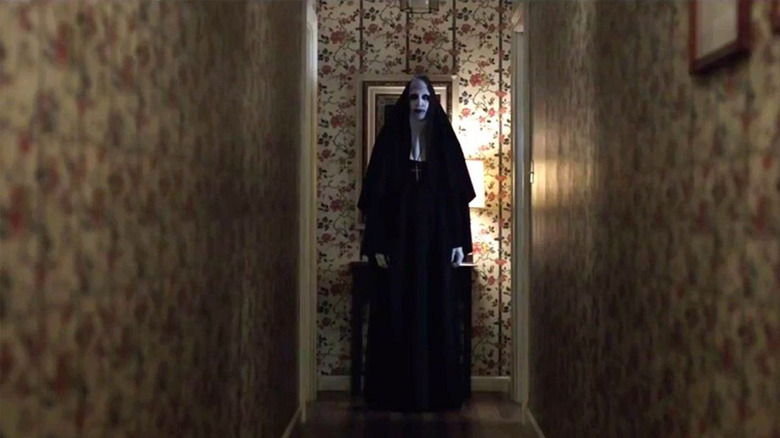
In the intricate lore of James Wan's Conjuring-verse, Valak is the closest thing paranormal investigators Ed and Lorraine Warren have to an overarching Big Bad. The demon gets his time in the spotlight in "The Nun," but has also made appearances in three other movies in the franchise to date. First summoned by a Romanian Duke, the fallen angel soon gets cozy on earth and begins possessing nuns at a secluded monastery.
Valak's fear factor depends on what face he's wearing: in "The Nun," the demon masquerades as a nun, showing off his ability to infiltrate the most respected orders of the religion that rebukes him. Valak's nun form is decidedly freaky, but he can be even scarier when he's less obvious.
Despite being able to take over human bodies, Valak seems compelled to taunt his prey. He spells his name in blocks behind Lorraine's head while she sleeps or appears in the back of one of Sister Charlotte's photographs without her noticing. His show of force is sometimes blatant, but other times he can be more sinister and creeping in his methods. No matter what form he takes, he's freaky as hell. (Valerie Ettenhofer)
Bruce
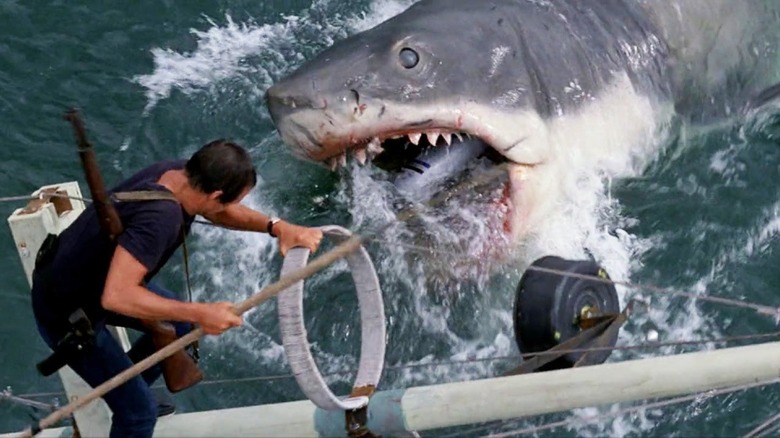
Steven Spielberg delivered perhaps one of the most universal terrors in cinema history in 1975 with "Jaws." Not only did he essentially create the summer blockbuster as we know it, but "Jaws" introduced us to one of the most terrifying monsters to ever grace the silver screen. So what made the shark affectionately known as Bruce so terrifying? This was a little too close to reality to be comfortable.
It all starts with that famous tagline, "You'll never go in the water again." Virtually anyone who has ever seen "Jaws" has likely experienced a moment of hesitation before setting foot in a big body of water. What lies just below the surface? Is there some beast full of razor-sharp teeth looking for an easy meal? It's a combination of the very real, as sharks have been around for millions of years, and the unknown that lies just out of sight that makes Bruce so viscerally terrifying. It certainly doesn't hurt that the shark itself is monstrous, not to mention the impact of John Williams' iconic theme, but the fact that so much of the horror and death is about what we aren't seeing is what makes it so horrifying.
Sometimes our imaginations can fill in those gaps better than anything tangible ever could. (Ryan Scott)
The Gwoemul
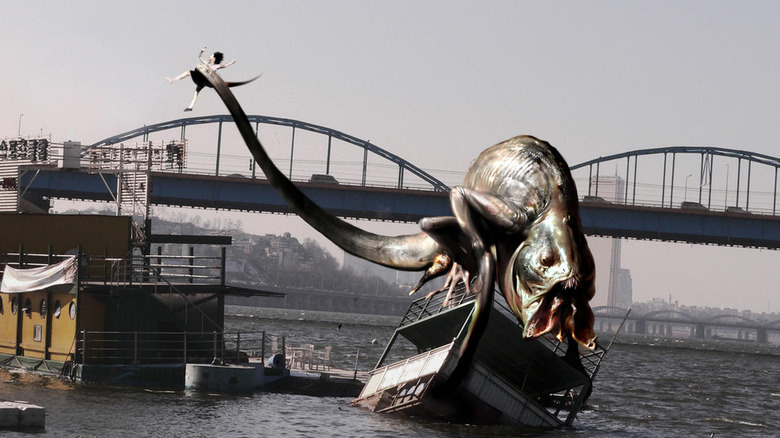
Though South Korean filmmaker Bong Joon-ho is no stranger to the socially conscious thriller, his 2006 film "The Host" plays with a distinct twist in the sub-genre. After American-sanctioned negligence results in 400 bottles of formaldehyde being poured into Seoul's Han River, all the fish die while something terrifying begins to mutate and take shape. When a string of sightings crop up, all detailing a strange, amphibian creature roaming the riverbanks, a monster finally emerges from the murky depths, wreaking havoc on the city and its populace. In a frenzied panic, snack stall owner Park Gang-du (Song Kang-ho) even loses his young daughter Hyun-seo (Go Ah-sung) to the monster's slimy clutches.
Dubbed the Gwoemul (Korean for "monster"), the creature resembles a cross of a fish and a salamander, with some horrifying new additions. It boasts a multi-pronged, gaping mouth and a prehensile tail. What makes the creature so eerie, though, is the fact that its backstory has real-world origins. In 2000, the U.S. really did dump all that formaldehyde into the Han River, causing actual mutations in the indigenous fish population. Theoretically, the Gwoemul could emerge from the river's waters at any moment, and America would be totally to blame. (Natalia Keogan)
Chucky
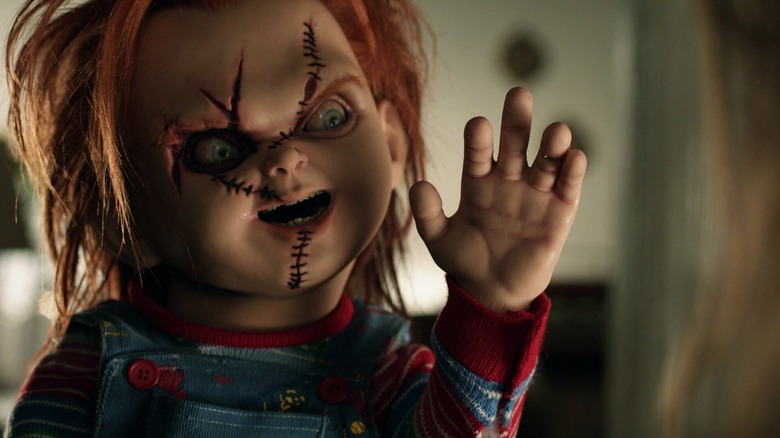
To many Spencer's Gifts patrons, Chucky is a friend 'till the end. To others, he's a devil doll whose cackle echoes through countless nightmares. Serial killer Charles Lee Ray becomes the horror icon we know and fear when transfers his soul into the rubbery vessel of a Good Guy doll. Brad Dourif plays the "Lakeshore Strangler" and lends his voice to Chucky in plaything form, defining his career as the most seasoned slasher villain since Chucky's debut in 1988's "Child's Play." Dourif's the only one who's played the demented doll in Mancini's ongoing canon and there's no end in sight with "Chucky" season 2 on the way.
"But Chucky's a jokester slasher and two-feet-tall!" Valid points, but Chucky's stitched Frankenstein style unveiled in "Bride Of Chucky" is unsettling and grotesque. He goes from a walking, talking evil doll to a terrifying monster. Laugh all you want, but the Chucky fear is real — innocence bastardized into maniacal malevolence in a red-headed package.
Dolls are supposed to be cute and cuddly, not possessed by wanted criminals. Chucky makes us fear what we should love, and for that reason alone, he's a scary story legend. (Matt Donato)
Bughuul
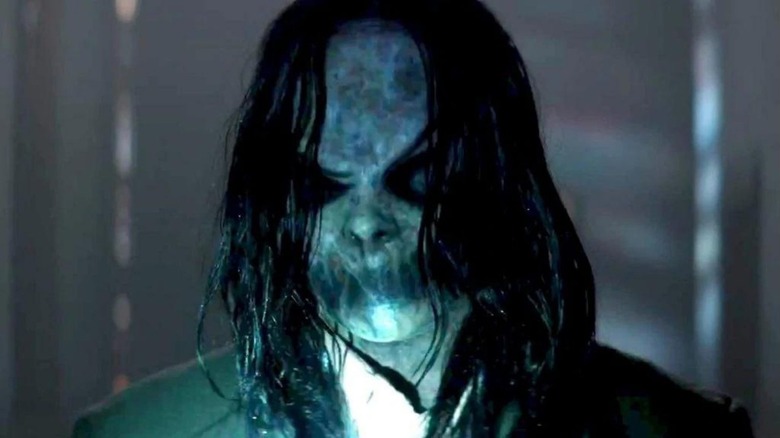
In "Sinister," another child-eating horror monster is introduced to the silver screen. The film tells the story of a true-crime novelist who accidentally unleashes Bughuul, an angry pagan deity that devours the souls of children. Don't be fooled because Bughuul is not your average child-eating monster; he possesses children and influences them to murder their families in some seriously gruesome ways. Once they've committed the crime, the creature transports the children to the netherworld, where he slowly consumes their souls.
With blotchy gray skin and shoulder-length black hair, Bughuul takes a human-like form. You might mistake him for a human before getting a glimpse of his dreadful face — he even wears a suit. It was thought that he possessed children through images, from frescoes to film reels. What makes Bughuul so dangerous beyond his ability to control the minds and souls of children is his longevity and adaptability. The Eater of Children's origins can be traced back to Babylonian times, when he was once accused of religious plagiarism after replicating his brother Moloch's child sacrifice rituals ... which caused the latter to shut his mouth with ash for eternity. (Fatemeh Mirjalili)
The Pale Man
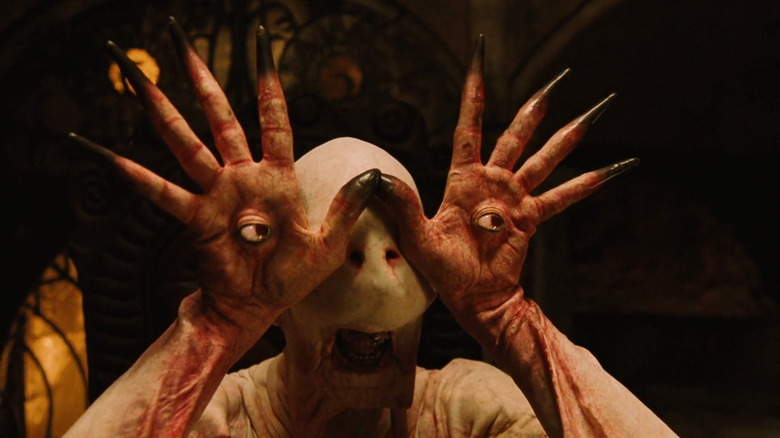
Guillermo Del Toro knows a few things about movie monsters. The writer and director won an Oscar for "The Shape of Water," about a woman who falls in love with a fish-man, after all, and he has a clear love for the monstrous. Arguably his most horrifying creation, however, came earlier in his career, with the 2006 historical fantasy horror, "Pan's Labyrinth." Doug Jones plays both the enigmatic Faun and the nightmarish Pale Man, and the latter is truly the stuff of Del Toro's darkest dreams.
The Pale Man is a pale, naked man who is very thin, but has way too much skin. It hangs off of him like a robe, and his facial features are mostly missing, making him pretty unpleasant to look at. Once he opens up his hands and reveals that his eyes are on his palms, however, he goes from unpleasant to downright appalling, and that's before he chomps on a cute little faerie like it was a Flamin' Hot Cheeto. Del Toro once described him as a representation of "all institutional evil feeding on the helpless," and if that's not terrifying, what is? (Danielle Ryan)
The Lasser Glass
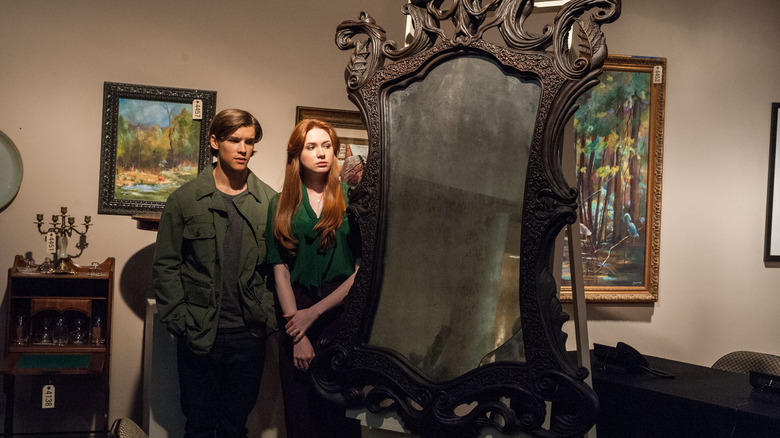
Most of the monsters on this list are alive in some quantifiable way, but the villain at the heart of "Oculus" wears the mask of an inanimate object. The Lasser Glass, a mirror that's killed 45 people and counting is one sick puppy, capable of manipulating reality for anyone who comes near it. In Mike Flanagan's pulse-pounding film, it faces off against Kaylie (Karen Gillan) and Tim (Brenton Thwaites), two traumatized siblings whose family was ripped apart by the mirror years ago.
While most cursed objects are revealed to be associated with some outside participant or demonic presence, in "Oculus," the Lasser Glass is the presence. The antique has been taking lives since at least 1754, including killing the pair's parents. It can bend perceptions in a deeply creepy and tragic way, relentlessly messing with time, space, and its victims' heads.
It can also, memorably, make a person take a bite out of a light bulb.
The heroes of "Oculus" are extra-clever horror movie protagonists, making their continued inability to overcome the mirror's dark enchantments all the more terrifying. (Valerie Ettenhofer)
Homerton (AKA Annihilation's Screamy Bear)
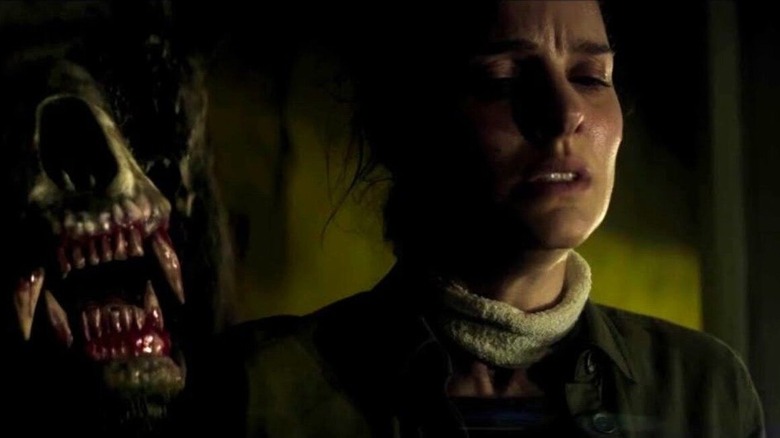
Cosmic horror is a tough thing to depict. It is, by its very nature, beyond the comprehension of the human mind. Man's grasp on reality and humanity is tethered to markers, things that make a person what and who they are. Movies like Alex Garland's 2018 adaptation of Jeff VanderMeer's novel "Annihilation" successfully slice at those tethers, not with tentacles that supernatural horror authors like H.P. Lovecraft were known for, but by presenting surpassed boundaries of the imagination.
One of the most jarring examples the story uses is of a creature that stalks the explorers tasked to probe into a bizarre quarantined zone. The four-legged beast looks enough like some kind of prehistoric bear, but with a few notable differences: a human skull is embedded on the left side of the creature's head, and it can emit a call that not only sounds human, but like the specific voice of one of the explorers it killed earlier in the film. This bear is not mimicking its victims; its victims assimilate into its body, meaning that they might not be truly dead once their physical form shuffles off its mortal coil. And that is cosmically horrifying. (Anya Stanley)
Cenobites
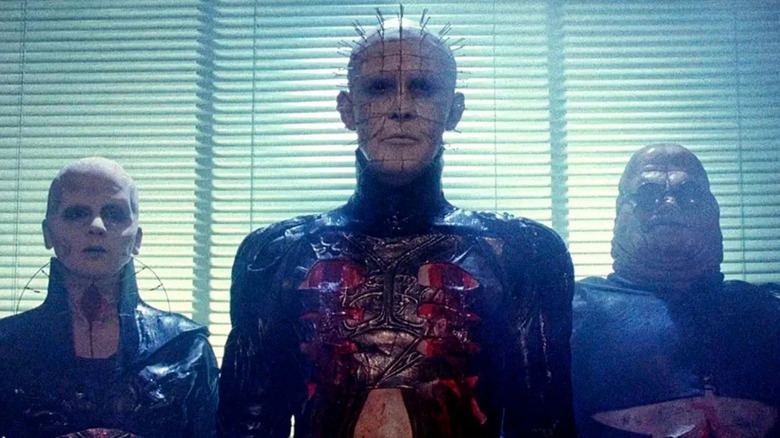
The original "Hellraiser" is a genuinely scary, goopy, gory horror movie with a wonderfully demented premise. The original film doesn't officially introduce audiences to Pinhead, the most recognizable of the extra-dimensional sickos called Cenobites. He gets more time to shine later, but initially, viewers are subjected to a whole league of supernatural sadomasochists. The Cenobites appear when daring humans seek out pleasures beyond their capacity, as Frank (Sean Chapman) does in the 1987 film. His escapades don't quite work out, as he loses his human body in a deeply disgusting way after beckoning the Cenobites with a magic puzzle box.
Although the Cenobites' torturous impact can be deeply disturbing, the dudes themselves are as entertaining as they are scary. With lipless bared teeth, mutated heads, and, of course, pins stuck through their faces, the Cenobites are like eldritch body mod freaks with a knack for rending flesh from bones. Over the series' 10 movies and counting, they're a persistently dangerous — and admittedly cool-looking — presence. (Valerie Ettenhofer)
Freddy Krueger
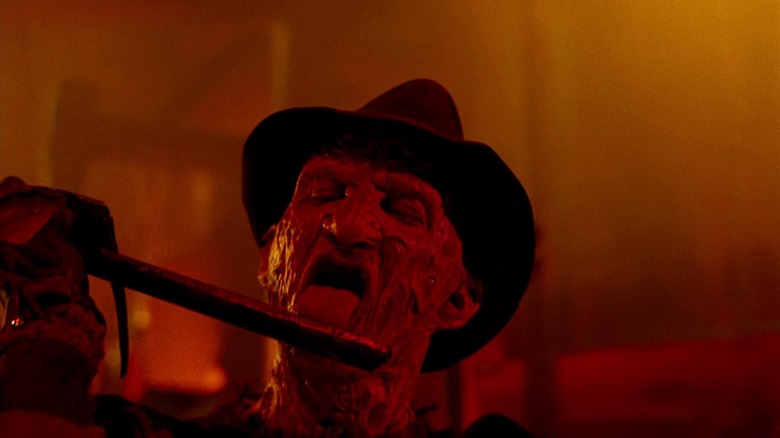
There are few instances where someone can just utter a single name and a myriad of images will pop into their mind. Simply say "Freddy," and anyone who even has a surface-level knowledge of pop culture will conjure images of Freddy Krueger from "A Nightmare on Elm Street." Robert Englund's depiction of the slasher who comes for you in your dreams is so singular and sticky that the name Freddy almost entirely belongs to him. It's that strong. Wes Craven first introduced us to the sweater-wearing, claw-handed killer in 1984, and for nearly four decades now, he's been one of the premiere names in the world of terror.
From a visual standpoint, Freddy is unparalleled. This is a foreboding figure to look at, with his scarred and melted skin and those sharp claws. Beyond that, what Freddy has that other slashers don't is the ability to get you when you are most vulnerable; in your sleep. Run from it, hide from it ... it's fruitless. Everyone sleeps. Everyone dreams. And that's when Freddy is gonna come for you. (Ryan Scott)
Sadako And Samara
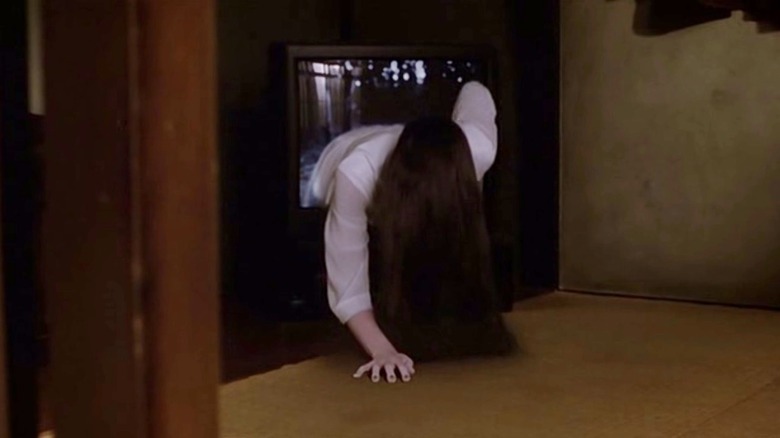
Regardless of whether someone watches the Japanese "Ringu" or the American remake, "The Ring," chances are they're going to be terrified of a little girl with long black hair. Sadako, or Samara in her American iteration, is a ghostly figure whose voice tells people they will die in seven days after they watch a cursed videotape. She's on the VHS, crawling out of a well with her long hair over her eyes, and she eventually crawls right out of the television screen and into the reality of the movie in a sequence that is utterly surreal.
Sadako doesn't have to say much beyond the old "seven days" line, because she's perfectly horrifying all on her own. There's something innately creepy about children in long gowns, and Sadako's feral movements and Cousin Itt-style hair make her even creepier. Samara and Sadako both went on to star in several sequels in their respective franchises, and Sadako even got the chance to duke it out with Kayako from "Ju-On" for "Sadako vs. Kayako" — a true duel of terror. (Danielle Ryan)
Pennywise
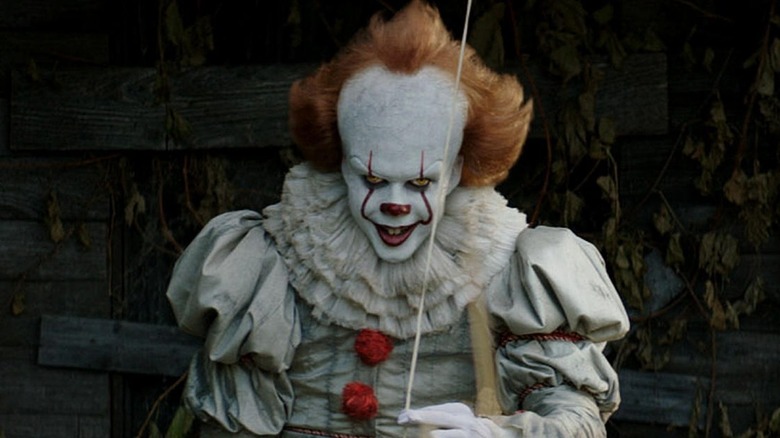
Regardless of whether you find clowns threatening, you have to agree that Bill Skaskarg's iteration of Pennywise the dancing clown from "It" (2017) is one of the most menacing, terrifying creatures to grace the horror genre. The otherworldly, trans-dimensional evil entity that preys upon the innocent young children of Derry, Maine, is the overarching antagonist of Stephen King's 1986 horror novel of the same name. The clown lives in the sewers in the town of Derry, using them as access points to lure his victims into his hideout.
The shape-shifting monster embodies every child's worst nightmare — the creature feeds off of their fears and weaponizes them. Pennywise's many forms are frightening, as the film sees him shape-shift into a mummy, an abusive father, a creepy painting, and a decapitated boy, just to name a few examples. The ancient entity can transform into anything to elicit a sense of fear in its victims. It assumes these forms to inspire as much terror as possible ... because simply butchering them is not enough. (Fatemeh Mirjalili)
The Babadook
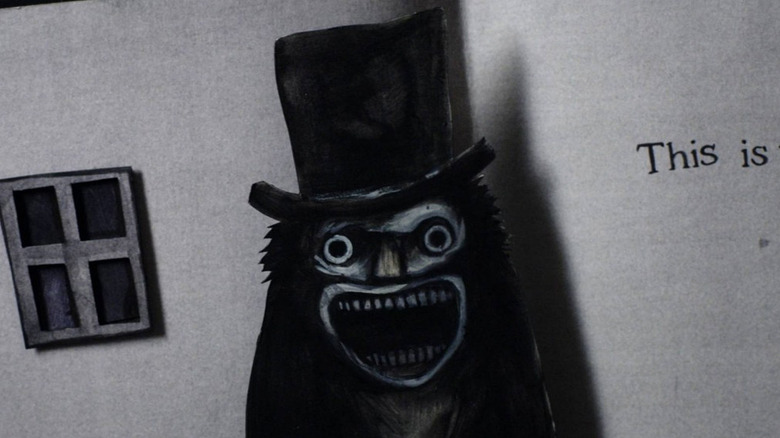
Contrary to popular assumption, recognizable horror icons did not disappear after "Scream." In fact, one of modern horror's contributions was directly influenced by a classic killer.
In Jennifer Kent's 2014 psych-horror banger "The Babadook," the Australian writer-director crafts a monster representing, among other things, the contradictory struggles of parenthood — that same parenthood that some people insist is always a blessing.
Single mother Amelia Vanek (Essie Davis) is raising her troubled son Sam (Noah Wiseman), her sanity hanging on by a thread. Sam brings a bedtime story to her titled "Mister Babadook," featuring a spindly white-faced human-ish creature in a top hat, with long, taloned fingers. Sporting an uncanny grin with what seems like way too many teeth, the Babadook torments his victims once they learn about him. Its ability to infiltrate, possess, and compel its victims to kill is its most terrifying power, but there lies plenty of nightmare material in the Babadook's expressionist aesthetic alone.
Fun fact: the creature took some visual cues from the long-lost 1935 mystery film "London After Midnight," starring Lon Chaney in dual roles including the Man in the Beaver Hat, a vampiric, wild-eyed figure with tiny sharp teeth, often bared in a terrible grin. (Anya Stanley)
Xenomorphs And Facehuggers
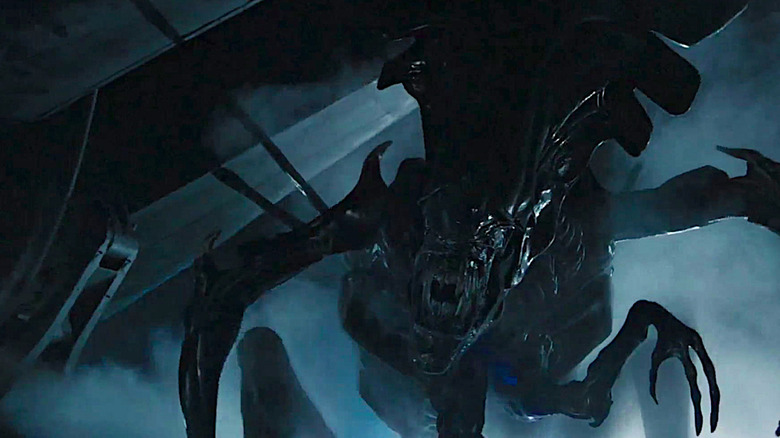
1979 saw the cinematic introduction of one of the most recognizable and frightening creatures to ever grace our screens: the Xenomorph. Making its big-screen debut in Ridley Scott's "Alien," it stalks the corridors of the Nostromo and kills off its crew one by one. It's a frightening beast by almost every metric you can apply. From its acid blood and its secondary retractable maw to its sharp tail and hive-mind connection to the Queen and other Xenos, it's a formidable and deadly foe. Even worse is its shocking and surprising life cycle.
Once a hapless victim arrives at a Xenomorph egg, it opens up to release a Facehugger: tough, bony crawlers that leap onto the victim's face and impregnate them with a Xenomorph fetus. The young alien feeds off its host's body until it bursts out of their chest, killing them almost instantly. It then rapidly grows into a full-fledged and horrifying adult. Every stage of the process is terrifying and violent, and the result is a mixture of Xenomorph and the species of its victim. In other words, every single aspect of its being is a deadly violation of the natural order as we know it, making for one terrifying beast that finds new ways to scare with each film. (Jeff Ewing)
The Thing
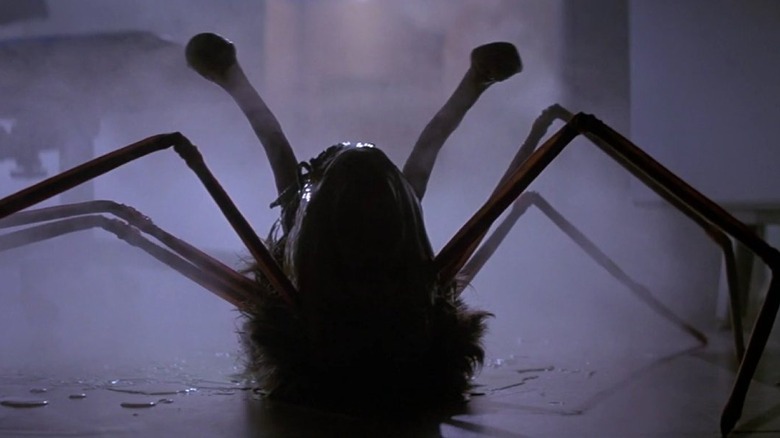
As one of the most well-known and revered horror movies, John Carpenter's 1982 classic "The Thing" barely requires an introduction. But the Cliffs Notes version follows a team of American researchers in Antarctica led by R.J. MacReady (played by Kurt Russell), befouled by a parasitic alien organism that mimics the form of whatever life it consumes.
It's hard to say what the creature's true form is since it incorporates its victims and imitates them. That's part of the film's tension; Childs (Keith David) asks, "If I was an imitation, a perfect imitation, how would you know it was really me?" But the Thing of "The Thing" is the scariest mid-transformation, when uncanny faces and clearly human organic matter mix and mingle with tentacles and foreign goo. One of the movie's greatest scenes puts Rob Bottin and his fx team's skills on display as the organism, hiding within a now-dead researcher, swiftly eliminates a threat and divides itself to ensure its own survival. The sight of the researcher's head, now sporting arachnid legs and antennae, only gets one vocal response from Palmer: "You gotta be f***ing kidding." (Anya Stanley)
Read this next: 15 Must-See Horror Anime Movies
The post The 30 Scariest Horror Movie Monsters Ranked appeared first on /Film.
Revisiting the "Satanic panic" of the 1980s in Stranger Things season 4

On Polygon, tabletop game historian, Jon Peterson (Playing at the World, The Elusive Shift) looks at the "Satanic panic" of the 1980s, which serves as one of the themes in season 4 of Stranger Things.
It is an interesting piece about how TSR certainly flirted with real-world occultism and demonology as they knew interest in the subject and its transgressive nature would attract players. — Read the rest
Think you're safe from all that tainted Jif peanut butter because you don't eat it? Well, think again, my smug friend. Turns out lots of other companies use Jif to make their stuff, too. So ha, you're still probably gonna die [Scary]
Young Boba Fett Actor Daniel Logan Learned Jango Fett Got Decapitated At The Attack Of The Clones Premiere
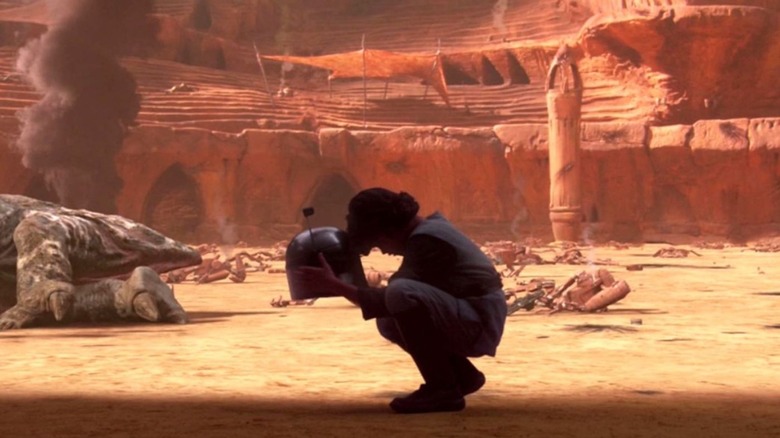
With "Attack of the Clones" celebrating its 20th anniversary (he types before he crumbles into an ancient pile of old man dust), there's a big focus on the often derided second prequel at this year's "Star Wars" Celebration. There are panels, signers on the autograph floor, "Attack of the Clones" merchandise, Hayden Christensen and Ewan McGregor taking a victory lap in the wake of "Obi-Wan Kenobi," the works.
Part of this focus was a panel that included "Attack of the Clones" cast members Temuera Morrison and Daniel Logan, who played Jango and Boba Fett in the second film, respectively. Logan was only 13 when he shot this movie and as such some small details might have been kept from him — namely that his on-screen dad lost his head.
Logan recalled that George Lucas almost overlooked the shot of young Boba picking up his father's helmet and had to find the actor as he was changing out of his wardrobe, getting ready to head home. The scene was just Lucas, Logan, and the camera and the direction was "I'm going to need you to crouch down and put the helmet to your head as softly as you can."
Laughing, Logan said when Lucas demonstrated the scene he only crouched down on one knee, which is something he understands now that he's in his 30s. But back then he had a young man's knees and "I kinda did it like I was taking a number two."
Lucas Kinda Left Out An Important Detail
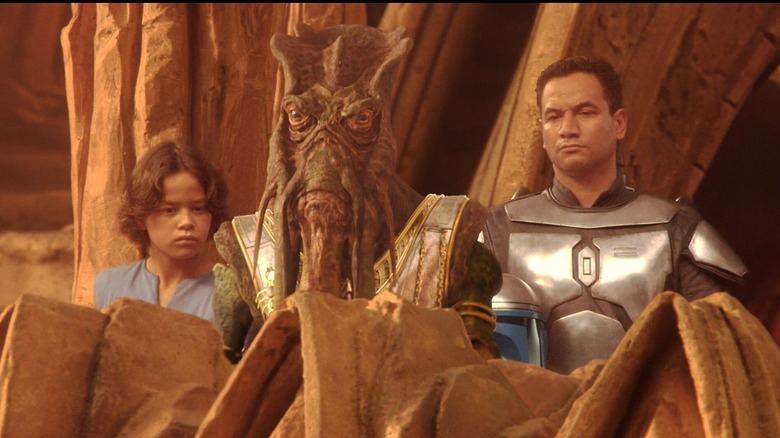
The kicker to this story is that Lucas neglected to tell the young actor just how his character's dad's helmet ended up on the ground in the arena scene and Logan didn't learn until the premiere that Jango Fett got his head chopped off.
While everybody else at the premiere was somber at the moment, Logan said he cheered because one, it was a surprise to him, and two, this opened the door for him to be in "Star Wars: Episode III — Revenge of the Sith."
Or so he thought.
The only one of the two to be invited back for "Revenge of the Sith" was Morrison who came back as "another clone," much to Logan's chagrin.
However, he did repeatedly call the beheading scene "the greatest scene in 'Attack of the Clones'" despite it not leading to a bigger role for him in the next film. Morrison interjected a quiet "unbelievable" at this declaration, by the way, which got huge laughs from the "Star Wars" Celebration audience.
It definitely feels like the prequels are entering a major re-evaluation phase in pop culture, spurred on by the coming of age of its target audience upon release and the way storytellers like Dave Filoni, Jon Favreau, and Deborah Chow have been adding on to and enriching the mythology George Lucas set up. For a whole generation, this is their "Star Wars," and they're not being quiet about their fandom.
Read this next: The 35 Best Documentaries You Can Watch On Netflix Right Now (March 2022)
The post Young Boba Fett Actor Daniel Logan Learned Jango Fett Got Decapitated at the Attack of the Clones Premiere appeared first on /Film.
Alexis Bledel Is Leaving The Handmaid's Tale
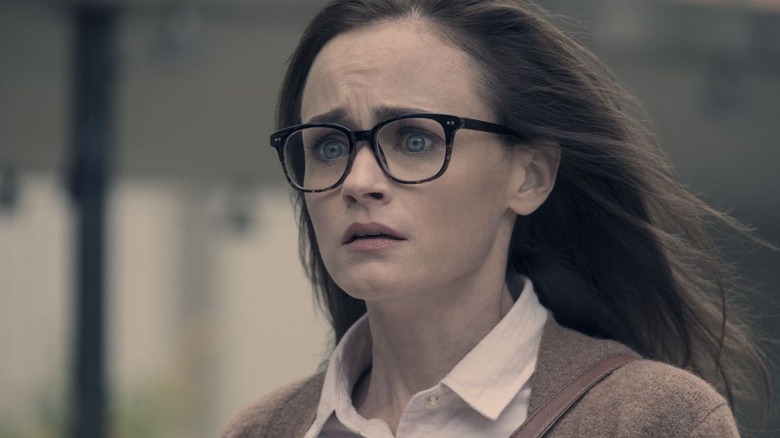
After four seasons, Alexis Bledel is departing "The Handmaid's Tale," which earned her four consecutive Emmy nominations and one win for her role as Emily Malek, a.k.a. Ofglen/Ofsteven. The Hulu series, created by Bruce Miller and based on Margaret Atwood's 1985 dystopian novel, is gearing up for what could be its final season, and Bledel has been with it since it premiered in 2017. The actress issued a statement to Variety about her departure, saying:
"After much thought, I felt I had to step away from 'The Handmaid's Tale' at this time. I am forever grateful to Bruce Miller for writing such truthful and resonant scenes for Emily, and to Hulu, MGM, the cast and crew for their support."
No additional reasons were given for her departure. Bledel's character last appeared in "The Wilderness," the season 4 finale of "The Handmaid's Tale," which aired in June 2021 and saw her and series protagonist June Osborne (Elizabeth Moss) chasing Commander Fred Waterford (Joseph Fiennes) through the forest to enact justice on him.
The Future Of The Handmaid's Tale
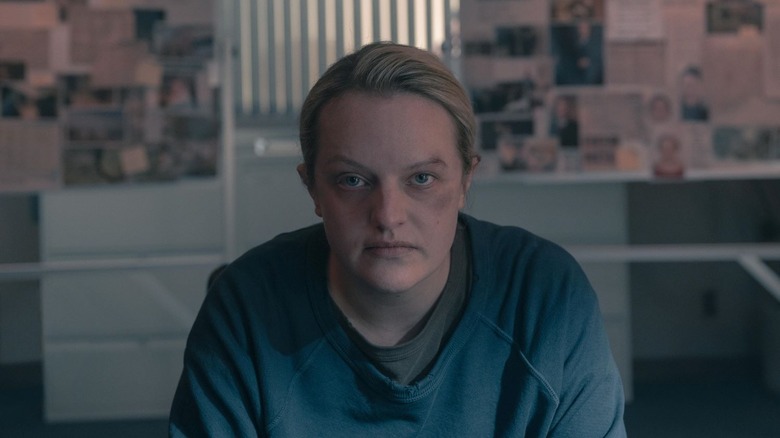
Reviews for the fourth season of "The Handmaid's Tale" were down from previous seasons; it currently holds a 69% on Rotten Tomatoes compared to the first season's 94%. Last summer, Jordan Helman, Hulu's Head of Scripted Originals, seemed to indicate that the show might be winding down in favor of an adaptation of Atwood's follow-up novel, "The Testaments," which puts Ann Dowd's character, Aunt Lydia, in a more prominent role. Helman told Deadline, "The birth of 'The Testaments' on Hulu and the eventual end of 'The Handmaid's Tale' are related, we're figuring out that as we speak."
Moss has remained busy outside "The Handmaid's Tale." She's currently starring in another streaming series, "Shining Girls," on Apple TV+, and she also serves as an executive producer for that series and has directed some episodes. Her most recent film projects include Wes Anderson's "The French Dispatch" and Taika Waititi's upcoming "Next Goal Wins."
As for Bledel, her role in "The Handmaid's Tale" was preceded by a recurring role on "Mad Men," the "Gilmore Girls: A Year in the Life" miniseries in 2016, and she also made an appearance in the film "Crypto" in 2019 but has remained mostly committed to the one show during its run. It seems a little late to recast the role of Emily; though the character's absence could always be explained in dialogue, it remains to be seen how "The Handmaid's Tale" will handle Bledel's departure.
Read this next: Batman Movies Ranked From Worst To Best
The post Alexis Bledel Is Leaving The Handmaid's Tale appeared first on /Film.
Mesa's Lavapipe Now Officially Vulkan 1.2 Conformant
Hundreds Stranded After Ransomware Attack on Indian Airline
Hundreds of Indian air travellers were stranded inside their planes after the low-cost airline SpiceJet cancelled or delayed flights due to an "attempted ransomware attack", the company has said.
Linux 5.19 ARM Excites With Apple M1 NVMe, 12 Year Old Multi-Platform Achievement
Top Gun: Maverick Ending Explained: The Need For Speed (And Redemption)
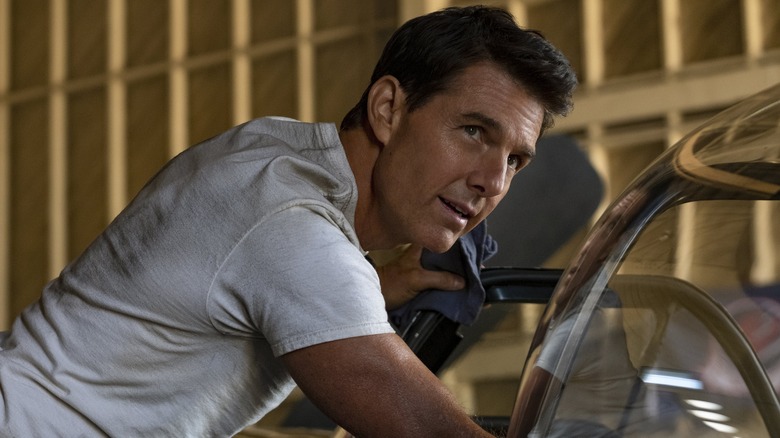
Spoiler warning: This article will openly discuss the plot and the ending of "Top Gun: Maverick"
In Joseph Kosinski's "Top Gun: Maverick," Tom Cruise plays Pete Mitchell, a Navy jet pilot who is still doing the same things at age 59 as he was doing at age 24. Namely: He's flying planes very quickly, wearing a very particular leather jacket and aviator shades (fair play for an aviator), and zipping around various military installations on his vintage motorcycle. The motorcycle wasn't vintage when he started riding it. Pete spends most of his days flexing, working on machines, smiling dazzlingly to himself, and living up to his (self-appointed?) nickname of Maverick. Maverick is less a human being as a distant collection of 1980s movie clichés, which is fitting, given Cruise codified the "Maverick" character type in Tony Scott's 1986 blockbuster/clunker "Top Gun." Since then, Cruise has made a career of showing off how inhuman and un-aging he is.
"Maverick" covers many of the same plot and character beats as the 1986 original: A team of hotshot pilots, each of them playfully rebellious (but not so rebellious as to be ejected from the Navy), indistinguishable from parodies of themselves, must perform a very difficult jet attack that needs to be accomplished on a specific time frame. In the case of "Maverick," Pete Mitchell now serves as the hotshots' teacher, naturally demanding the near-impossible: Be as fecklessly cool as Tom Cruise in "Top Gun." Few are equal to the task.
The Star Wars Mission
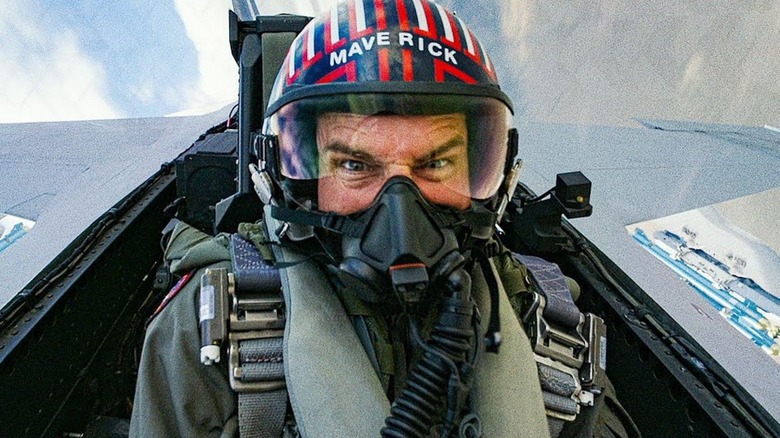
After an opening act of introductory material (Maverick is the same character, there are some new hotshots, one of them is Rooster, played by Miles Teller, the son of Anthony Edwards' character from the 1986 film), the audience is informed that someone — someone — has their hands on some nuclear material hidden in a bowl-shaped mountain bunker somewhere in the world. It's never specified in what country the bunker is located (it's snowy and can be accessed by aircraft carrier) or what nation stole the nuclear materials. The soldiers only know they have been ordered to fire missiles at it. Their mission will be a parallel of "Star Wars," wherein the pilots have to fly down a very narrow valley, mere feet off the ground, to avoid radar detection. They will then have to fly over a mountain ridge and down into a crater where the bunker is located. One team of planes will blow open the crater, and a second team immediately behind them will shoot a missile down inside of it. To escape, the pilots will have to fly out of the crater over a very tall mountain, risking blackouts because of the g-forces, and avoiding enemy missiles. With the Nintendo mission in place, training can begin.
The Unchanging Maverick

The arc of Pete Mitchell is still, as it was in the original, a flatline. There aren't a lot of lessons he needs to learn, nor changes he needs to make. Maverick stepped into the world fully formed, and it's up to the world to match his intensity. Watching such a character can be exhilarating; Maverick may serve as an aspirational character for 8-year-olds who need unflappability lessons. And indeed, others come around: By the end of "Top Gun," his former rival Iceman (Val Kilmer, who returns for "Maverick") becomes his friend (and perhaps lover, although that's not fully explored). He loses a compatriot, but it wasn't so much Maverick's attitude or recklessness that killed him as the vague indignities of an unnamed war.
Kosinski's "Maverick" presented an opportunity for the title character to — perhaps — change. It's 2022, Ronald Reagan is no longer in office, and the public's attitudes about war have carried through quagmires in Iraq and Afghanistan. Gung-ho fantasies about fast jets and missiles may not have the same implications as they did in 1986. It's high time to reconsider Maverick. It's time for him to lose something, to sacrifice something for the greater good, to look inward and ask if his lifetime of being ultra-cool and endlessly capable has gotten him anything.
But who am I kidding? One doesn't watch a long-in-the-tooth "Top Gun" sequel hoping that its unchanging, inhuman hero will change ... unless we look at the ending in the right light.
Andy Klein's Theory Of 'War Of The Worlds'
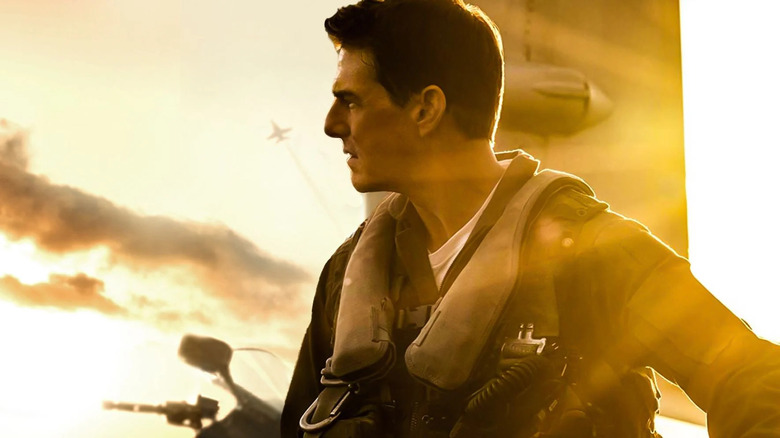
Film critic Andy Klein once wrote a brilliant review of the 2005 Steven Spielberg sci-fi disaster movie "War of the Worlds," also starring Cruise. The review is, sadly, no longer online, but in it, Klein posited that there were in fact no aliens in the movie and that Cruise's character — a bad divorced dad who his kids hate — was actually having an elaborate rescue fantasy wherein he would be permitted to be the hero in his kids' lives. With the world falling apart, Cruise finally gets to step up and re-earn his family's affection. Klein's theory certainly makes sense, given "Worlds'" treacly family reunion ending.
The end of "Maverick" has a similar read. The pilots in question enact the mission described, more or less without a hitch. During the daring escape, however, the character of Rooster (Miles Teller) is spared from enemy fire by Maverick's hotdogging midair maneuvers. Maverick's plane is shot down, and Maverick presumably dies. At best, he'll be stranded behind enemy lines in the country of [cough, cough, speech trails off]. Maverick sacrificed his life to save the son of a fallen comrade and finally lost something in the process: His own life. This is the perfect ending for Maverick's story. He considered someone else to be more important than himself for a brief moment. Rooster and his friends will fly back home, pleased that the mission was complete, saddened at the death of their teacher, but inspired by his sacrifice. And Maverick, who has long felt guilty for the death of Goose, is redeemed by saving Goose's son Rooster by sacrificing his own life.
Soon, The Wolves Will Appear
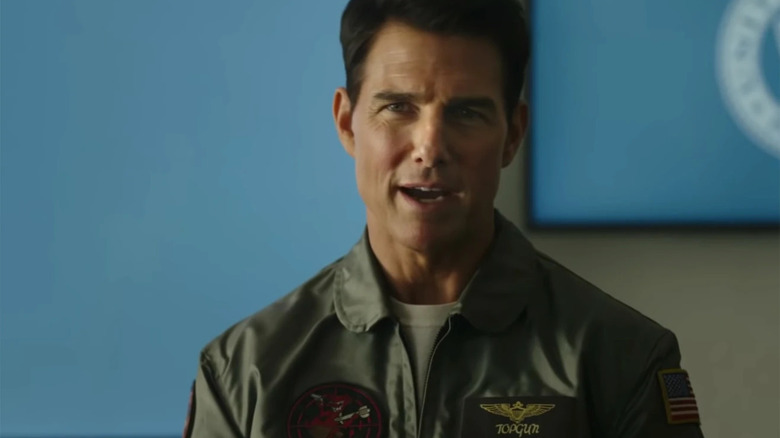
But of course, Maverick can't die. Instead, there's a big climax in which Rooster returns, saves Maverick, and the two of them back to the aircraft carrier together. If you want, feel free to think of it as a fantasy sequence. The remainder of "Top Gun: Maverick" could very well be the end-of-life mental throes of a dying Maverick as he freezes to death, broken and bleeding, in the woods. He imagines the following events: Rooster, in defiance of orders, returns to Maverick's crash site, bailing out merely to check on him. Maverick is unbroken, unbruised, actually in a pretty good mood. Old guy's still got it.
But how will the two now return to base? As chance would have it, the Enemy has a small, protected hangar with a 1986-era jet hidden inside of it. Maverick and Rooster hijack the jet, perform a daring, short-runway takeoff, and fight their way through the attacks of enemy jets to make it to freedom. It's a good thing an old guy who knows about old jets was there. His know-how saved you young whippersnappers. Maverick walks away from the drama, still unflappable, still unchanged, having inspired those around him to come to his rescue and assure his cool will live forever as he races around with his newest girlfriend, bartender Penny (Jennifer Connelly). Generation X will never die, and Maverick is here to prove it. Let's listen to some hair metal and ponder joining the Navy. These would indeed be the final thoughts of a dying Maverick as he bleeds into the snow, his legs far from the rest of his body. Soon, the wolves will stalk out of the woods. Death is coming, Maverick. However cool you are, death comes for us all.
"Top Gun: Maverick," in the spirit of the 1986 original, is slick, awesome, exciting, and completely empty. It's on track to become an enormous hit, just as the original was. And, with the right kind of eyes, features a fitting death for a heroic icon. Or it just gives Maverick another happy ending. Whichever works for you.
Read this next: The 35 Best Documentaries You Can Watch On Netflix Right Now (March 2022)
The post Top Gun: Maverick Ending Explained: The Need for Speed (And Redemption) appeared first on /Film.
Jurassic Park's Mr. DNA Mascot Solved A Major Problem With The Script
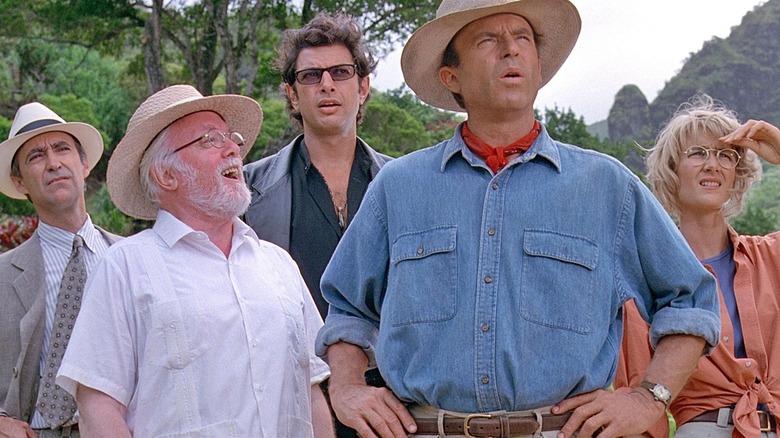
One of the biggest challenges in adapting a novel into a movie is figuring out how to cram all the exposition into a decently moderate run time. Such was the problem Steven Spielberg faced when Universal won the bidding war to turn Michael Crichton's 448-page novel "Jurassic Park" into a film. But that wasn't the only hurdle. The director already had a big enough conundrum on his plate: figuring out how to realistically bring to life the dinosaurs that were undoubtedly its central stars. Spielberg's salvation? Luckily, the director had a dream team working on the script, with David Koepp arriving to assist and then completing the working script Crichton had started. Then there was the wizardry of Industrial Light & Magic's Dennis Muren ("Terminator 2: Judgment Day"), who provided the means to create the revolutionary effects for the dinosaurs in "Jurassic Park." But it would take all three — Spielberg, Koepp, and Murren's effects — to solve their exposition problem. They accomplished it by coming up with easily the most underrated character in the film.
Mr. DNA To The Rescue
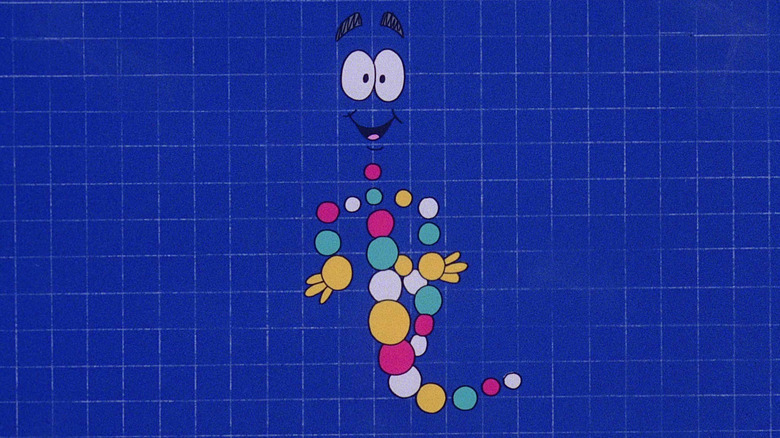
In an Entertainment Weekly oral history of "Jurassic Park," David Koepp described their issues with finding an organic way to insert the "vast amount of scientific exposition" of the novel into the movie:
"How on earth do you get that in a movie? I remember Steven [Spielberg] and I were wrestling with that very issue, about the DNA, and one of us said, 'What are we supposed to do? Have a little animated character called Mr. DNA?' And the other one said, 'Yes! That's exactly what we're going to do!'"
Mr. DNA (voiced by Greg Burson) might only appear in one scene in the film, but he's always been a memorable part, a kind of unofficial mascot for the park. It's also no accident he makes his debut during the informational film park creator John Hammond (Richard Attenborough) screens for his guests. Spielberg drew on memories from his childhood for Mr. DNA's inspiration:
"When I was a kid, the AV kids used to wheel in the projector and show these Frank Capra-produced and -directed documentaries on the mind, the heart, and the sun. I just remember all the interstitial animation that was done to illustrate the science and thought, 'Why don't we do all this in a two-minute animated handbook for the audience?' It would be easy for everybody to understand how this is even possible to bring dinosaurs back."
Since Jurassic Park was a theme park, what better way to ease curious parents and children through the complexities of dinosaur cloning than with a cartoonish short? Burson, who voiced numerous "Looney Tunes" and other legendary cartoon characters, lent Mr. DNA a buoyant personality that helped transformed him into a kind of Mickey Mouse for "Jurassic Park."
Koepp Was Essential To Adapting Jurassic Park
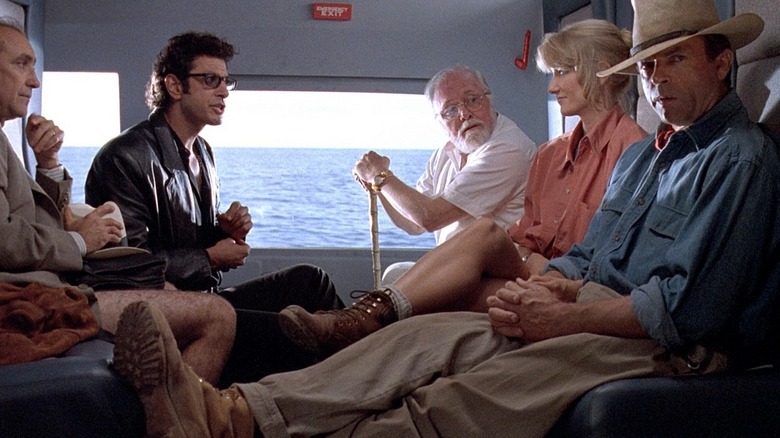
The idea for Mr. DNA might've come from Steven Spielberg, but that doesn't mean David Koepp wasn't instrumental in adapting the rest of Michael Crichton's novel. By the time he'd joined, the original author was long gone and had left behind a rough draft of the script. Koepp told Consequence in an interview that he actually "never met Crichton." In retrospect, however, the screenwriter — especially in the eyes of Spielberg — is the reason "Jurassic Park" is the movie it ended up being. The director told EW:
"David basically took it from a banquet to fast food and that's a compliment because the movie feels like a drive-thru. The scenes are tight. The story David wrote is a page-turner. There's just enough science to make it credible and then it's a downhill race from then on."
The succinct style of storytelling obviously made it easier for Spielberg and Koepp to solve their exposition problems. But it also meant they could produce a faithful adaptation of the novel. Early on it was considered that Ian Malcolm (Jeff Goldblum) might be conflated into Alan Grant (Sam Neill) — thankfully that didn't happen in Koepp's script. In special features footage from the "Jurassic Park" Blu-ray, it's even revealed that he's responsible for adding much of the dynamics between characters, from Grant's arc with Hammond's grandchildren to Malcolm's flirtation with Ellie Satler (Laura Dern). And much like the Mr. DNA scene, the moment in the Jeep when Malcolm demonstrates his chaos theory to Sattler with a few drops of water is just another example of Koepp condensing important character illustrations into concise but impressionable scenes.
The Origin Of A Great Samuel L. Jackson Line
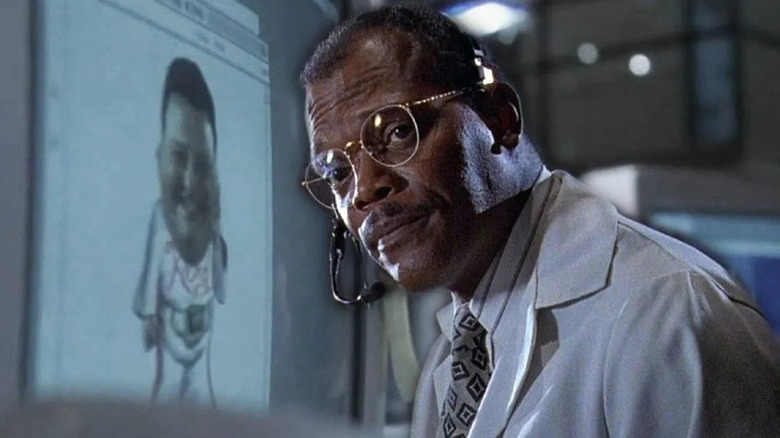
One of the reasons Steven Spielberg chose David Koepp to complete the "Jurassic Park" script was director Robert Zemeckis. He'd worked with the screenwriter on his recent film "Death Becomes Her" and told Spielberg as much. But Zemeckis has another albeit unwitting contribution to "Jurassic Park," and this one involves one of the film's many standout side characters, Ray Arnold (Samuel L. Jackson). "Hold on to your butts," Arnold says grimly as prepares to reboot the park's power through puffs of a cigarette. This quote in particular is pretty ingrained in my library of most used phrases, and according to a Reddit AMA, Koepp said it came from Zemeckis:
"It was something I heard Robert Zemeckis say, when we were working on 'Death Becomes Her' but I had the good sense to jot it down immediately and use it!"
As evidenced by Mr. DNA's small but memorable role, in "Jurassic Park," side characters are just as important as its central ones. Sometimes that's because of general badassery, as with Arnold and game warden Robert Muldoon (Bob Peck). More often than not, though, it's because they're destined to be dinosaur meals, like when lawyer Donald Gennaro (Martin Ferrero) gets munched by a Tyrannosaurus rex on the toilet or Dennis Nedry (Wayne Knight) gets eaten by a dilophosaurus. Such moments offer up many of the film's best quotes: "When you gotta go, you gotta go," Malcolm muses when Gennaro runs for the bathroom. Or when Nedry mistakes hunger for playful stupidity: "Nice juicy stick! Fetch!" and then later "Walnut brain ... extinct kangaroo ... hope I run over you on the way down." Although hands down, the film's best quote is Muldoon's "clever girl," delivered just seconds before he takes a velociraptor bite to the face.
Read this next: 12 Shows Like Stranger Things You Definitely Need To Stream
The post Jurassic Park's Mr. DNA Mascot Solved a Major Problem With The Script appeared first on /Film.






